Basic Role of Extrusion Processes in the Late Cenozoic Evolution of the Western and Central Mediterranean Belts
Abstract
:1. Introduction


2. Oligocene Configuration, Driving Forces and Tectonic Processes
3. From the Late Oligocene to the Middle-Late Miocene (Migration of the Alpine-Iberian Belt, Building of the Apennine Belt and Formation of the Balearic Basin)
- -
- -
- The strong bending that the Arc underwent during its migration, changing from a more or less straight configuration (Figure 1A) to its final shape, characterized by two almost perpendicular sectors (Figure 5), is consistent with a SSW-NNE driving force induced by the convergence between Nubia and Europe (e.g., [1,13,89,114]). Conversely, the modelling of the slab-pull mechanism cannot reproduce such strong arc’s curvature ([13,29] and references therein, [115]).
- -
- A sinistral transpressional deformation is recognized in the Alpine–Iberian belt during the phase which preceded its detachment from western Europe (e.g., [41,116]), i.e., a regime which is compatible with the one which was induced in the Oligocene by the left lateral displacement of the Alpine-Iberian belt with respect to Western Europe (Figure 3).
- -
4. From the Late Miocene to the Latest Miocene–Early Pliocene (Formation of the Northern Tyrrhenian Basin and Extension–Subsidence of the Northern Apennines)
5. From the Late Miocene-Early Pliocene to the Late Pliocene-Early Pleistocene (Reorganization of the Tectonic Setting in the Central Mediterranean Area)
- -
- -
- -
- -
- Some longitudinal oroclinal arcs developed in the Apennine belt ([149]).
- -
- -
- A major fracture (Sicily Channel and Victor Hensen–Medina fault systems, Figure 7) developed in the Pelagian foreland and the Ionian oceanic zone (e.g., [146,151,152,153,154,155,156,157] and references therein [158]). In the Sicily Channel the main transcurrent fault system was associated with some troughs (Pantelleria, Malta and Linosa (e.g., [159,160,161,162,163]). Dextral shear occurred along the Sciacca fault [162,163].
- -
- The formation of the present orocline in the Sicilian Apennines (Gela nappe) is mostly attributed to the southward bowing of that belt, driven by E-W compression (e.g., [164]).
- -
- -
- -
- In the northern Adriatic foreland an old weak zone was reactivated as a sinistral NNW-SSE fault system (Schio–Vicenza), (Figure 7, e.g., [71,139,169,170]). Since then, NW-SE to North–South shortening has affected the Alpine sector lying east of the Schio-Vicenza fault, whereas such activity almost ceased west of that fault (e.g., [171,172]).
- -
- A system of thrust faults reactivated as dextral strike-slip faults along the northeastern border of the Adria plate (Northern Dinarides, e.g., [173]).


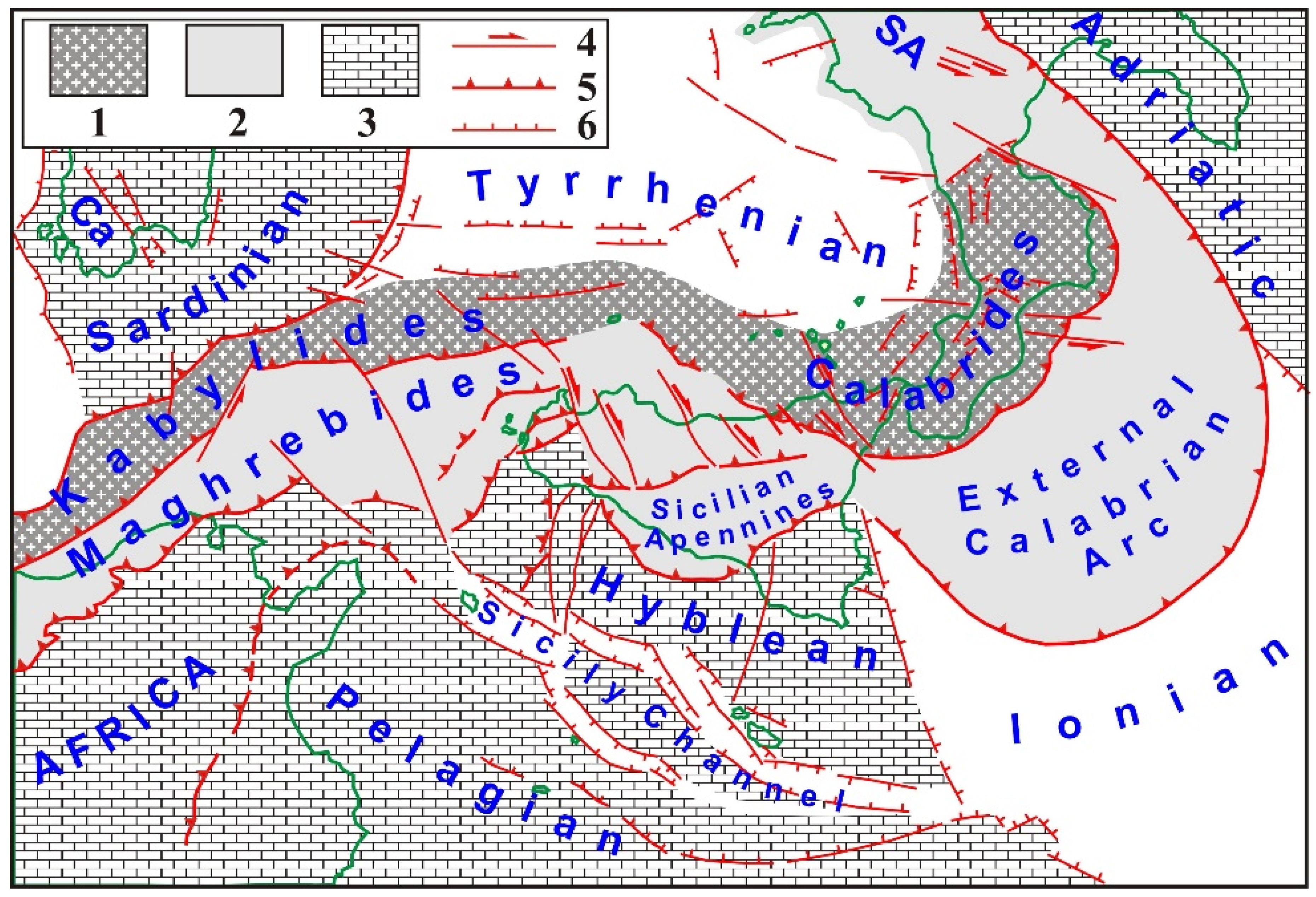
6. From the Early Pleistocene to the Middle–Upper Pleistocene (Suture of the Southern Apennines Consuming Boundary and Formation of the Marsili Basin)
- -
- -
- -
- -
- -
- -
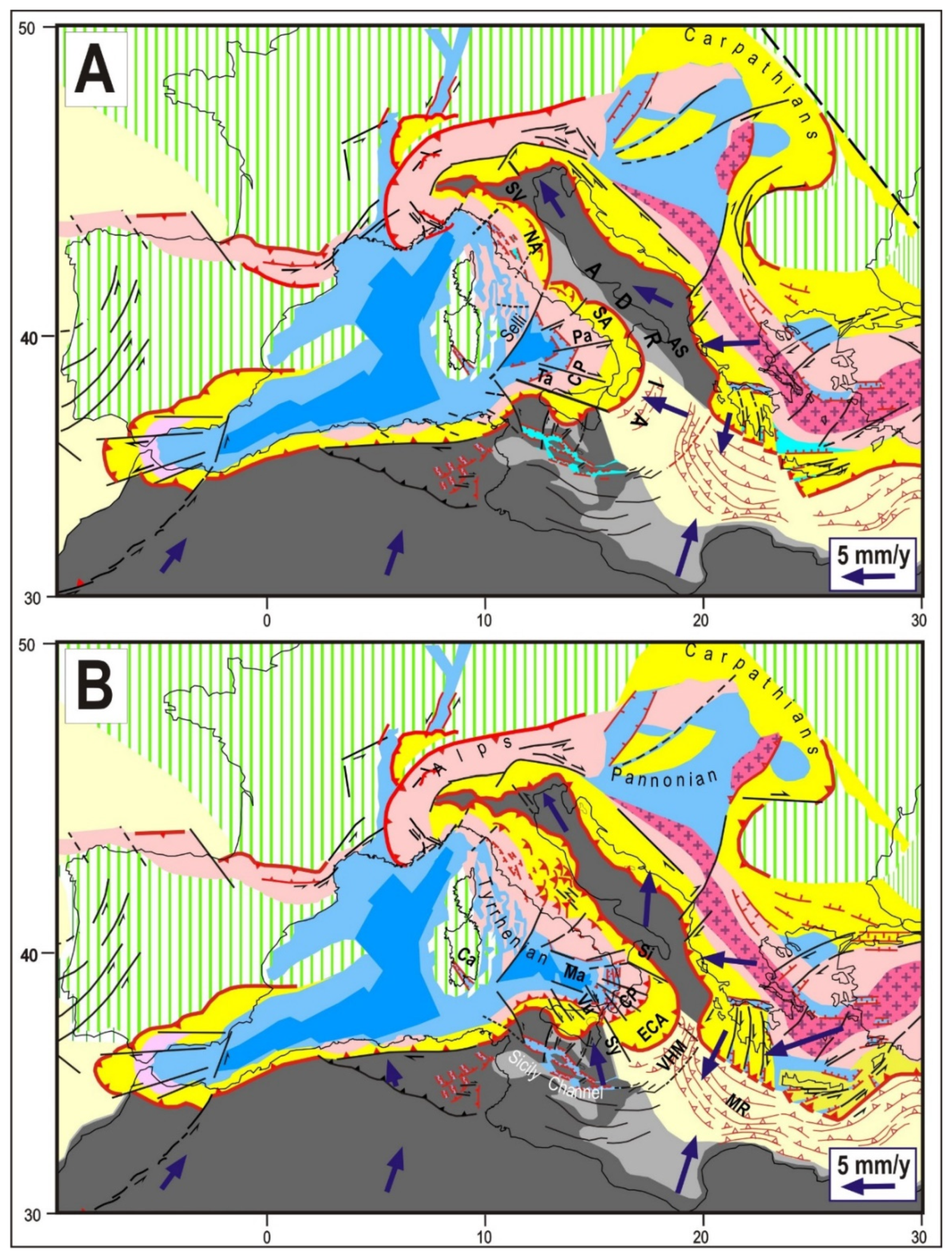
7. From the Middle Pleistocene to the Present (Northward Acceleration of Adria, Belt Parallel Shortening and Uplift in the Apennines)
- -
- -
- -
- -
- -
- Sinistral transtensional faults are recognized in the axial part of the Northern Apennines (e.g., [223,224,225,226]), whereas thrusting dominates in the outer border of that zone (e.g., [227,228,229]). The observed deformation pattern mainly indicates uplift and widening of the Northern Apennine range [147].
- -
- -
- -
- -
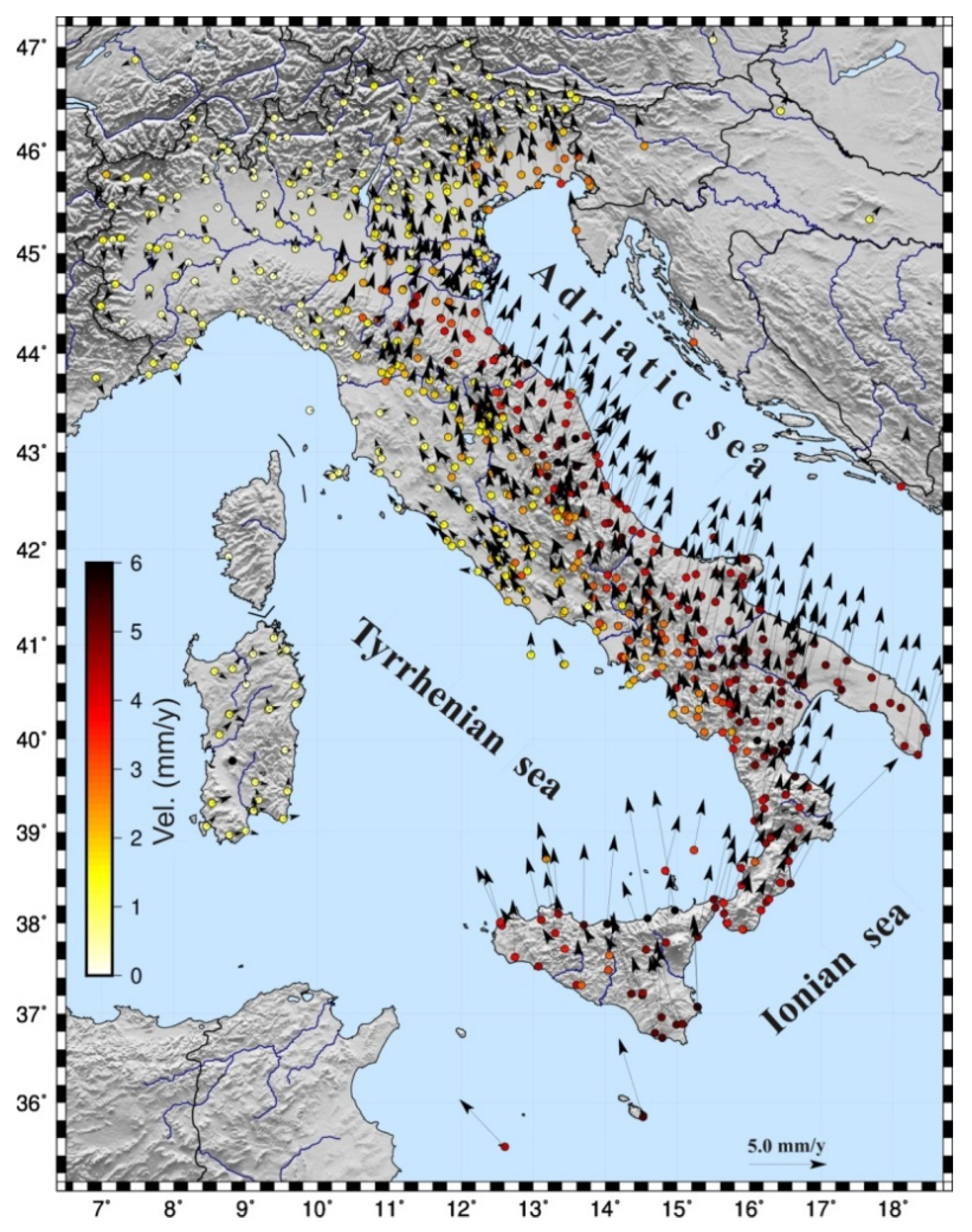
8. Conclusions
- -
- The comparison between the Oligocene (Figure 1A) and the middle Miocene configurations (Figure 4B) shows that the northernmost sector of the northern Iberian Arc (running from the Western Alps to Corsica) underwent a counterclockwise rotation and left lateral shift. This is confirmed by the analysis of paleomagnetic data ([261]) which quantify the rotation in about 50°. Such deformation is compatible with the SW-NE Nubia-Eurasia convergence here proposed (Figure 1A, Figure 3 and Figure 4), whereas it cannot be reconciled with the effects of the roughly southeastward traction that would have been exerted by the presumed slab-pull driving force.
- -
- Geological evidence suggests that the consuming process which built up the Eocene Alpine–Iberian belt involved the southward subduction of the Tethys oceanic lithosphere under the oceanic domain facing the western Adriatic margin (e.g., [41,180,262,263]). This implies that the beginning of extension in the Balearic basin, coinciding with an inversion of the subduction direction at that plate boundary, can hardly be attributed to slab-pull forces, since the new embryonal northward subducting lithosphere was not long enough to induce an appreciable gravitational sinking.
- -
- The occurrence of a major break in the European foreland, with the formation of the Rhine-Rhone graben system, cannot easily be reconciled with the effects of a slab-pull force in the Western Mediterranean region. Conversely, the interpretation here proposed provides plausible explanations for this event (Figure 3), concerning the observed sinistral transtensional stress regime in Western Europe, the timing of its occurrence and its progressive attenuation over time (corresponding well to the increasing curvature of the migrating Arc).
- -
- Numerical modelling of slab-pull mechanisms ([13] and references therein [29]) indicate that such driving force cannot reproduce the strong bending that the migrating Arc underwent, forming two almost perpendicular segments (Figure 4). This deformation would have required a very peculiar distribution of trench retreat rates along the Arc, with much higher values in the central sector with respect to lateral sectors. However, one should explain why the presumed subducted lithosphere beneath the almost linear initial Arc (Figure 1A) may have induced such pattern of retreat rates in its various sectors.
- -
- The retreat of the northern Tyrrhenian slab would have started around the uppermost Miocene (9 My), i.e., about 5–7 My after the Middle Miocene cessation of crustal extension in the Balearic basin. This stop and go of slab retreat cannot easily be justified.
- -
- At about 9 My, the subducted lithosphere beneath the Southern Apennines and Calabria was certainly more developed than the one lying under the Northern Apennines. Thus, one should explain why the slab-pull mechanism would have occurred only under the second zone for about 3 My.
- -
- -
- Some major tectonic events occurred in the northern Adriatic area during the formation of the northern Tyrrhenian basin, such as the reactivation of the Giudicarie fault system, the stop of tectonic activity in the Western Alps and the strengthening of thrustings in the Eastern Alps. Our interpretation suggests a close connection between the above events and the formation of the Northern Tyrrhenian basin. Since such events cannot easily be explained as effects of slab pull forces, the supporters of such models must identify another independent cause to account for the observed tectonic activity in the northern Adriatic zones.
Author Contributions
Funding
Data Availability Statement
Conflicts of Interest
References
- Dercourt, J.; Zonenshain, L.P.; Ricou, L.E.; Kazmin, V.G.; Le Pichon, X.; Knipper, A.L.; Grandjacquet, C.; Sbortshikov, I.M.; Geyssant, J.; Lepvrirer, C.; et al. Geological Evolution of the Tethys Belt from the Atlantic to the Pamirs since the LIAS. Tectonophysics 1986, 123, 241–315. [Google Scholar] [CrossRef]
- Dewey, J.F.; Helman, M.L.; Turco, E.; Hutton, D.H.W.; Knott, S.D. Kinematics of the western Mediterranean. Geol. Soc. Lond. Spec. Publ. 1989, 45, 265–283. [Google Scholar] [CrossRef]
- Patacca, E.; Scandone, P. Post-Tortonian Mountain Building in the Apennines. The Role of the Passive Sinking of a Relict Lithospheric Slab. In The Lithosphere in Italy. Advances in Earth Science Research; Boriani, A., Bonafede, M., Piccardo, G.B., Vai, G.B., Eds.; Accademia Nazionale dei Lincei: Roma, Italy, 1989; Volume 80, pp. 157–176. [Google Scholar]
- Sartori, R.; Capozzi, R. Patterns of Neogene to Recent Rift-Related Subsidence in the Tyrrhenian Domain. In Sedimentary Basins: Models and Constraints; Cloetingh, S., Ranalli, G., Ricci, C.A., Eds.; Tipografia Senese: Siena, Italy, 1998; pp. 147–158. [Google Scholar]
- Finetti, I.R. Geodynamic Evolution of the Mediterranean Region from the Permo-Triassic Ionian Opening to the Present, Constrained by New Lithospheric CROP Seismic Data. In CROP PROJECT, Deep Seismic Exploration of the Central Mediterranean and Italy; Finetti, I.R., Ed.; Elsevier: Amsterdam, The Netherlands, 2005; Chapter 34; pp. 767–776. [Google Scholar]
- Finetti, I.R. Ionian and Alpine Neotethyan Oceans Opening. In CROP PROJECT, Deep Seismic Exploration of the Central Mediterranean and Italy; Finetti, I.R., Ed.; Elsevier: Amsterdam, The Netherlands, 2005; Chapter 6; pp. 103–107. [Google Scholar]
- Finetti, I.R.; Del Ben, A. Ionian Tethys Lithosphere Roll-Back Sinking and Back-Arc Tyrrhenian Opening from New CROP Seismic Data. In CROP PROJECT: Deep Seismic Exploration of the Central Mediterranean and Italy; Finetti, I.R., Ed.; Elsevier: Amsterdam, The Netherlands, 2005; Chapter 21; pp. 483–504. [Google Scholar]
- Mantovani, E. Evolutionary Reconstruction of the Mediterranean Region: Extrusion Tectonics Driven by Plate Convergence. In CROP PROJECT: Deep Seismic Exploration of the Central Mediterranean and Italy; Finetti, I.R., Ed.; Elsevier: Amsterdam, The Netherlands, 2005; Chapter 32; pp. 705–746. [Google Scholar]
- Schmid, S.M.; Bernoulli, D.; Fugenschuh, B.; Matenco, L.; Schefer, S.; Schuster, R.; Tischler, M.; Ustaszewski, K. The Alpine-Carpathian-Dinaridic Orogenic System: Correlation and Evolution of Tectonic Units. Swiss J. Geosci. 2008, 101, 139–183. [Google Scholar] [CrossRef] [Green Version]
- Mantovani, E.; Babbucci, D.; Tamburelli, C.; Viti, M. A Review on the Driving Mechanism of the Tyrrhenian-Apennines System: Implications for the Present Seismotectonic Setting in the Central-Northern Apennines. Tectonophysics 2009, 476, 22–40. [Google Scholar] [CrossRef]
- Mantovani, E.; Viti, M.; Babbucci, D.; Tamburelli, C.; Cenni, N. How and Why the Present Tectonic Setting in the Apennine Belt Has Developed. J. Geol. Soc. Lond. 2019, 176, 1291. [Google Scholar] [CrossRef]
- Mantovani, E.; Viti, M.; Babbucci, D.; Tamburelli, C.; Cenni, N. Geodynamics of the Central Western Mediterranean Region: Plausible and Non-Plausible Driving Forces. Mar. Pet. Geol. 2020, 113, 104121. [Google Scholar] [CrossRef]
- Viti, M.; Mantovani, E.; Tamburelli, C.; Babbucci, D. Generation of Trench-Arc-Backarc Systems in the Western Mediterranean Region Driven by Plate Convergence. Boll. Della Soc. Geol. Ital. 2009, 128, 89–106. [Google Scholar]
- Handy, M.R.; Schmid, S.M.; Bousquet, R.; Kissling, E.; Bernoulli, D. Reconciling Plate-Tectonic Reconstructions with the Geologicalgeophysical Record of Spreading and Subduction in the Alps. Earth Sci. Rev. 2010, 102, 121–158. [Google Scholar] [CrossRef]
- Guillaume, B.; Funiciello, F.; Faccenna, C.; Martinod, J.; Olivetti, V. Spreading Pulses of the Tyrrhenian Sea during the Narrowing of the Calabrian Slab. Geology 2010, 38, 819–822. [Google Scholar] [CrossRef]
- Schettino, A.; Turco, E. Tectonic History of the Western Tethys since the Late Triassic. Geol. Soc. Am. Bull. 2011, 123, 89–105. [Google Scholar] [CrossRef]
- Milia, A.; Torrente, M.M.; Iannace, P. Pliocene-Quaternary Orogenic Systems in Central Mediterranean: The Apulia-Southern Apennines-Tyrrhenian Sea Example. Tectonics 2017, 36, 1614–1632. [Google Scholar] [CrossRef]
- Romagny, A.; Jolivet, L.; Menant, A.; Bessière, E.; Maillard, A.; Canva, A.; Gorini, C.; Augier, R. Detailed Tectonic Reconstructions of the Western Mediterranean Region for the Last 35 Ma, Insights on Driving Mechanisms. Bull. Société Géologique Fr. 2020, 191, 37. [Google Scholar] [CrossRef]
- Malinverno, A.; Ryan, W.B.F. Extension in the Tyrrhenian Sea and Shortening in the Apennines as Result of Arc Migration Driven by Sinking of the Lithosphere. Tectonics 1986, 5, 227–245. [Google Scholar] [CrossRef]
- Royden, L.H. Evolution of Retreating Subduction Boundaries Formed during Continental Collision. Tectonics 1993, 12, 629–638. [Google Scholar] [CrossRef]
- Faccenna, C.; Piromallo, C.; Crespo-Blanc, A.; Jolivet, L. Lateral Slab Deformation and the Origin of the Western Mediterranean arcs. Tectonics 2004, 23, TC1012. [Google Scholar] [CrossRef]
- Rosenbaum, G. Geodynamics of Oroclinal Bending: Insights from the Mediterranean. J. Geodyn. 2014, 82, 5–15. [Google Scholar] [CrossRef] [Green Version]
- Bouillin, J.-P. Le « Bassin Maghrebin »; Une Ancienne Limite Entre L’europe Et L’afrique à L’ouest Des Alpes. Bull. Société Géologique Fr. 1986, 2, 547–558. [Google Scholar] [CrossRef]
- Michard, A.; Chalouan, A.; Feinberg, H.; Goffé, B.; Montigny, R. How Does the Alpine Belt End between Spain and Morocco? Bull. Société Géologique Fr. 2002, 173, 3–15. [Google Scholar] [CrossRef]
- Michard, A.; Negro, F.; Saddiqi, O.; Bouybaouene, M.L.; Chalouan, A.; Montigny, R.; Goffé, B. Pressure-Temperature-Time Constraints on the Maghrebide Mountain Building: Evidence from the Rif-Betic Transect (Morocco, Spain), Algerian Correlations, and Geodynamic Implications. Comptes Rendus Geosci. 2006, 338, 92–114. [Google Scholar] [CrossRef]
- Mantovani, E.; Viti, M.; Babbucci, D.; Albarello, D. Nubia-Eurasia Kinematics: An Alternative Interpretation from Mediterranean and North Atlantic Evidence. Ann. Geophys. 2007, 50, 311–336. [Google Scholar] [CrossRef]
- Viti, M.; Mantovani, E.; Babbucci, D.; Tamburelli, C. Plate Kinematics and Geodynamics in the Central Mediterranean. J. Geodyn. 2011, 51, 190–204. [Google Scholar] [CrossRef]
- Faccenna, C.; Funiciello, F.; Giardini, D.; Lucente, P. Episodic back-Arc Extension during Restricted Mantle Convection in the Central Mediterranean. Earth Planet. Sci. Lett. 2001, 187, 105–116. [Google Scholar] [CrossRef]
- Schellart, W.P.; Freeman, J.; Stegman, D.R.; Moresi, L.; May, D. Evolution and Diversity of Subduction Zones Controlled by Slab Width. Nature 2007, 446, 308–311. [Google Scholar] [CrossRef]
- Tapponnier, P. Evolution Tectonique Du Système Alpin En Méditerranée: Poinçonnement Et Ecrasement Rigide-Plastique. Bull. Société Géologique Fr. 1977, 19, 437–460. [Google Scholar] [CrossRef]
- Boccaletti, M.; Conedera, C.; Dainelli, P.; Gocev, P. The Recent (Miocene-Quaternary) Regmatic System of the Western Mediterranean Region. J. Petrol. Geol. 1982, 5, 31–49. [Google Scholar] [CrossRef]
- Mantovani, E.; Viti, M.; Babbucci, D.; Tamburelli, C.; Cenni, N.; Baglione, M.; D’Intinosante, V. Generation of back-Arc Basins as Side Effect of Shortening Processes: Examples from the Central Mediterranean. Int. J. Geosci. 2014, 5, 1062–1079. [Google Scholar] [CrossRef] [Green Version]
- Driehaus, L.; Nalpas, T.; Cobbold, P.R.; Gelabert, B.; Sàbat, F. Effects of Margin-Parallel Shortening and Density Contrasts on back-Arc Extension during Subduction: Experimental Insights and Possible Application to Anatolia. Tectonophysics 2013, 608, 288–302. [Google Scholar] [CrossRef] [Green Version]
- Boutelier, D.; Gagnon, L.; Johnston, S.; Cruden, A. Buckling of Orogens: Insights from Analogue Modelling. J. Struct. Geol. 2019, 125, 213–217. [Google Scholar] [CrossRef]
- Boccaletti, M.; Dainelli, P. Il Sistema Regmatico Neogenico-Quaternario Nell’area Mediterranea: Esempio Di Deformazione Plastico-Rigida Post-Collisionale. Mem. Soc. Geol. Ital. 1982, 24, 465–482. [Google Scholar]
- Rehault, J.P.; Boillot, G.; Mauffret, A. The Western Mediterranean Basin: Geological Evolution. Mar. Geol. 1984, 55, 447–477. [Google Scholar] [CrossRef]
- Rehault, J.P.; Moussat, E.; Fabbri, A. Structural Evolution of the Tyrrhenian back-Arc Basin. Mar. Geol. 1987, 74, 123–150. [Google Scholar] [CrossRef]
- Dercourt, J.F.; Gaetani, M.; Vrielynck, B.; Barrier, E.; Biju-Duval, B.; Brunet, M.-F.; Cadet, J.P.; Crasquin, S.; Sandulescu, M. Atlas Peri-Tethys Paleogeographical Maps Vol.I-XX; CCGM/CGMW: Paris, France, 2000; pp. 1–269. [Google Scholar]
- Royden, L.H.; Baldi, T. Early Cenozoic Tectonics and Paleogeography of the Pannonian and Surrounding Regions. In The Pannonian Basin: A Study in Basin Evolution; Royden, L.H., Horvath, F., Eds.; American Association of Petroleum Geologists, AAPG Memoir: Tulsa, OK, USA, 1988; Volume 45, pp. 1–16. [Google Scholar]
- Vigliotti, L.; Laugenheim, V.E. When Did Sardinia Stop Rotating? New Paleomagnetic Results. Terra Nova 1995, 7, 424–435. [Google Scholar] [CrossRef]
- Finetti, I.; Boccaletti, M.; Bonini, M.; Del Ben, A.; Geletti, R.; Pipan, M.; Sani, F. Crustal Section Based on CROP Seismic Data across the North Tyrrhenian-Northern Apennines-Adriatic Sea. Tectonophysics 2001, 343, 135–163. [Google Scholar] [CrossRef]
- Casado, C.L.; De Galdeano, C.S.; Palacios, C.M.; Romero, J.H. The Structure of the Alboran Sea: An Interpretation from Seismological and Geological Data. Tectonophysics 2001, 338, 79–95. [Google Scholar] [CrossRef]
- Dèzes, P.; Schmid, S.M.; Ziegler, P.A. Evolution of the European Cenozoic Rift System: Interaction of the Alpine and Pyrenean Orogens with Their Foreland Lithosphere. Tectonophysics 2004, 389, 1–33. [Google Scholar] [CrossRef]
- Van Hinsbergen, D.J.J.; Schmid, S.M. Map-View Restoration of the Aegean back-Arc. Tectonics 2012, 31, TC5005. [Google Scholar] [CrossRef] [Green Version]
- Van Hinsbergen, D.J.J.; Torsvik, T.H.; Schmid, S.M.; Maţenco, L.C.; Maffione, M.; Vissers, R.L.M.; Gürer, D.; Spakman, W. Orogenic Architecture of the Mediterranean Region and Kinematic Reconstruction of Its Tectonic Evolution since the Triassic. Gondwana Res. 2020, 81, 79–229. [Google Scholar] [CrossRef]
- Jolivet, L.; Baudin, T.; Calassou, S.; Chevrot, S.; Ford, M.; Issautier, B.; Lasseur, E.; Masini, E.; Manatschal, G.; Mouthereau, F.; et al. Geodynamic Evolution of a Wide Plate Boundary in the Western Mediterranean, near-Field versus Far-Field Interactions. BSGF—Earth Sci. Bull. 2021, 192, 48. [Google Scholar] [CrossRef]
- Improta, L.; Moretti, M.; Govoni, A.; Pastori, M.; Chiarabba, C.; De Gori, P.; Dannowski, A.; Kopp, H. The Contribution of the Istituto Nazionale Di Geofisica E Vulcanologia (INGV) to “Adria LithosPHere investigAtion (ALPHA)” Active Seismic Experiment. Ann. Geophys. 2018, 61, SE667. [Google Scholar] [CrossRef]
- Robertson, A.H.F. Mesozoic-Tertiary Tectonic-Sedimentary Evolution of a South Tethyan Oceanic Basin and Its Margins in Southern Turkey. In Tectonics and Magmatism in Turkey and the Surrounding Area; Bozkurt, E., Winchester, J.A., Piper, J.D.A., Eds.; The Geological Society: London, UK, 2000; Volume 173, pp. 97–138. [Google Scholar]
- Finetti, I.R. The Calabrian Arc and Subducting Ionian Slab from new CROP Seismic Data. In CROP PROJECT, Deep Seismic Exploration of the Central Mediterranean and Italy; Finetti, I.R., Ed.; Elsevier: Amsterdam, The Netherlands, 2005; Chapter 17; pp. 393–412. [Google Scholar]
- Finetti, I.R. Understanding the Ionides and Their Geodynamics. In CROP PROJECT, Deep Seismic Exploration of the Central Mediterranean and Italy; Finetti, I.R., Ed.; Elsevier: Amsterdam, The Netherlands, 2005; Volume 10, pp. 197–208. [Google Scholar]
- Patacca, E.; Scandone, P. Geology of the Southern Apennines. Boll. Della Soc. Geol. Ital. 2007, 7, 75–119. [Google Scholar]
- Guerrera, F.; Martin-Martin, M.; Perrone, V.; Tramontana, M. Tectono-Sedimentary Evolution of the Southern Branch of the Western Tethys (Maghrebian Flysch Basin and Lucanian Ocean): Consequences for Western Mediterranean Geodynamics. Terra Nova 2005, 17, 358–367. [Google Scholar] [CrossRef]
- Robertson, A.H.F.; Dixon, J.E.; Brown, S.; Collins, A.; Morris, A.; Pickett, E.A.; Sharp, I.; Ustaömer, T. Alternative Tectonic Models for the Late Palaeozoic-Early Tertiary Development of Tethys in the Eastern Mediterranean Region. In Paleomagnetism and Tectonics of the Mediterranean Region; Morris, A., Tarlino, D.H., Eds.; The Geological Society: London, UK, 1996; Volume 105, pp. 239–263. [Google Scholar]
- Gessner, K.; Ring, U.; Passchier, C.W.; Güngör, T. How to Resist Subduction: Evidence for Large-Scale out-of-Sequence Thrusting during Eocene Collision in Western Turkey. J. Geol. Soc. 2001, 158, 769–784. [Google Scholar] [CrossRef] [Green Version]
- Ring, U.; Layer, P.W. High-Pressure Metamorphism in the Aegean, Eastern Mediterranean: Underplating and Exhumation from the Late Cretaceous until the Miocene to Recent above the Retreating Hellenic Subduction Zone. Tectonics 2003, 22, 1–23. [Google Scholar] [CrossRef]
- Golonka, J. Plate Tectonic Evolution of the Southern Margin of Eurasia in the Mesozoic and Cenozoic. Tectonophysics 2004, 381, 235–273. [Google Scholar] [CrossRef]
- Dilek, Y.; Furnes, H. Tethyan Ophiolites and Tethyan Seaways. J. Geol. Soc. 2019, 176, 899–912. [Google Scholar] [CrossRef]
- Handy, M.R.; Ustaszewski, K.; Kissling, E. Reconstructing the Alps-Carpathians-Dinarides as a Key to Understanding Switches in Subduction Polarity, Slab Gaps and Surface Motion. Int. J. Earth Sci. 2015, 104, 1–26. [Google Scholar] [CrossRef] [Green Version]
- Royden, L.H.; Burchfiel, B.C. Are Systematic Variations in Thrust Belt Style Related to Plate Boundary Processes? (The Western Alps versus the Carpathians). Tectonics 1989, 8, 51–61. [Google Scholar] [CrossRef]
- Okay, A.I.; Tüysüz, O. Tethyan Sutures of Northern Turkey. In The Mediterranean Basins: Tertiary Extension within the Alpine Orogen; Durand, B., Jolivet, L., Horváth, F., Seranne, M., Eds.; The Geological Society: London, UK, 1999; Volume 156, pp. 475–515. [Google Scholar]
- Schmid, S.M.; Fügenschuh, B.; Kounov, A.; Matenco, L.; Nievergelt, P.; Oberhansli, R.; Pleuger, J.; Schefer, S.; Schuster, R.; Tomljenovic, B.; et al. Tectonic Units of the Alpine Collision Zone between Eastern Alps and Western Turkey. Gondwana Res. 2020, 78, 308–374. [Google Scholar] [CrossRef]
- Sleep, N.H.; Stein, S.; Geller, R.J.; Gordon, R.G. Comment on “The Use of the Minimum-Dissipation Principle in Tectonophysics”, by P. Bird and D.A. Yuen. Earth Planet. Sci. Lett. 1979, 45, 218–220. [Google Scholar] [CrossRef]
- Molnar, P.; Lyon-Caen, H. Some Simple Physical Aspects of the Support, Structure and Evolution of Mountain Belts. In Processes in Continental and Lithospheric Deformation; Clark, S.P., Ed.; The Geological Society: Boulder, CO, USA, 1988; Volume 218, pp. 179–207. [Google Scholar]
- Masek, J.G.; Duncan, C.C. Minimum-Work Mountain Building. J. Geophys. Res. 1998, 103, 907–917. [Google Scholar] [CrossRef]
- Ranalli, G.; Murphy, D.G. Rheological Stratification of the Lithosphere. Tectonophysics 1987, 132, 281–295. [Google Scholar] [CrossRef]
- Lobkovski, L.I.; Kerchmann, V.I. A Two-Level Concept of Plate Tectonics: Application to Geodynamics. Tectonophysics 1991, 199, 343–374. [Google Scholar] [CrossRef]
- Cloos, M. Lithospheric Buoyancy and Collisional Orogenesis: Subduction of Oceanic Plateaus, Continental Margins, Island Arcs, Spreading Ridges, and Seamounts. GSA Bull. 1993, 105, 715–737. [Google Scholar] [CrossRef]
- Van den Beukel, J. Some Thermomechanical Aspects of the Subduction of Continental Lithosphere. Tectonics 1992, 11, 316–329. [Google Scholar] [CrossRef]
- Meissner, R.; Mooney, W. Weakness of Lower Continental Crust: A Condition for Delamination, Uplift and Escape. Tectonophysics 1998, 296, 47–60. [Google Scholar] [CrossRef]
- Viti, M.; Albarello, D.; Mantovani, E. Rheological Profiles in the Central-Eastern Mediterranean. Ann. Geofis. 1997, 40, 849–864. [Google Scholar]
- Castellarin, A.; Cantelli, L. Neo-Alpine Evolution of the Southern Eastern Alps. J. Geodyn. 2000, 30, 251–274. [Google Scholar] [CrossRef]
- Ceriani, S.; Schmid, S.M. From N-S Collision to WNW-Directed Post-Collisional Thrusting and Folding: Structural Study of the Frontal Penninic Units in Savoie (Western Alps, France). Eclogae Geol. Helv. 2004, 97, 347–369. [Google Scholar] [CrossRef]
- Rosenberg, C.L.; Kissling, E. 3D Insight into Central Alpine Collision: Lower Plate or Upper Plate Indentation? Geology 2013, 41, 1219–1222. [Google Scholar] [CrossRef]
- Stern, R.J. Subduction Initiation: Spontaneous and Induced. Earth Planet. Sci. Lett. 2004, 226, 275–292. [Google Scholar] [CrossRef]
- Copley, A.; Avouac, J.-P.; Royer, J.-Y. India-Asia Collision and the Cenozoic Slowdown of the Indian Plate: Implications for the Forces Driving Plate Motions. J. Geophys. Res. 2010, 115, B03410. [Google Scholar] [CrossRef] [Green Version]
- Hippolyte, J.C.; Murovskaya, A.; Volfman, Y.; Yegorova, T.; Gintov, O.; Kaymakci, N.; Sangu, E. Age and Geodynamic Evolution of the Black Sea Basin: Tectonic Evidences of Rifting in Crimea. Mar. Pet. Geol. 2018, 93, 298–314. [Google Scholar] [CrossRef] [Green Version]
- Hall, R. The Subduction Initiation Stage of the Wilson Cycle. In Fifty Years of the Wilson Cycle Concept in Plate Tectonics; Wilson, R.W., Houseman, G.A., Mccaffrey, K.J.W., Doré, A.G., Buiter, S.J.H., Eds.; The Geological Society: London, UK, 2018; Volume 470. [Google Scholar] [CrossRef] [Green Version]
- Mantovani, E.; Viti, M.; Albarello, D.; Tamburelli, C.; Babbucci, D.; Cenni, N. Role of Kinematically Induced Horizontal Forces in Mediterranean Tectonics: Insights from Numerical Modelling. J. Geodyn. 2000, 30, 287–320. [Google Scholar] [CrossRef]
- Mantovani, E.; Cenni, N.; Albarello, D.; Viti, M.; Babbucci, D.; Tamburelli, C.; D’Onza, F. Numerical Simulation of the Observed Strain Field in the Central-Eastern Mediterranean Region. J. Geodyn. 2001, 3, 519–556. [Google Scholar] [CrossRef]
- Mantovani, E.; Viti, M.; Babbucci, D.; Tamburelli, C. Major Evidence on the Driving Mechanism of the Tyrrhenian-Apennines Arc-Trench-back-Arc System from CROP Seismic Data. Boll. Soc. Geol. Ital. 2007, 126, 459–471. [Google Scholar]
- Ratschbacher, L.; Merle, O.; Davy, P.; Cobbold, P. Lateral Extrusion in the Eastern Alps, Part I: Boundary Conditions and Experiments Scaled for Gravity. Tectonics 1991, 10, 245–256. [Google Scholar] [CrossRef]
- Davy, P.; Hansen, A.; Bonnet, E.; Zhang, S.Z. Localisation and Fault Growth in Layered Brittle-Ductile Systems: Implications for Deformations of the Continental Lithosphere. J. Geophys. Res. 1995, 100, 6281–6294. [Google Scholar] [CrossRef]
- Faccenna, C.; Davy, P.; Brun, J.P.; Funiciello, R.; Giardini, D.; Mattei, M.; Nalpas, T. The Dynamics of back-Arc Extension: An Experimental Approach to the Opening of the Tyrrhenian Sea. Geophys. J. Int. 1996, 126, 781–795. [Google Scholar] [CrossRef] [Green Version]
- Shemenda, A.I. Subduction of the Lithosphere and back Arc Dynamics: Insights from Physical Modelling. J. Geophys. Res. 1993, 98, 167–185. [Google Scholar] [CrossRef]
- Boutelier, D.; Chemenda, A.; Jorand, C. Continental Subduction and Exhumation of High-Pressure Rocks: Insights from Thermo-mechanical Laboratory Modelling. Earth Planet. Sci. Lett. 2004, 222, 209–216. [Google Scholar] [CrossRef]
- Zhao, W.L.; Morgan, J. Uplift of Tibetan plateau. Tectonics 1985, 4, 359–369. [Google Scholar] [CrossRef]
- Westaway, R. Crustal Volume Balance during the India-Eurasia Collision and Altitude of the Tibetan Plateau: A Working Hypothesis. J. Geophys. Res. 1995, 100, 173–192. [Google Scholar] [CrossRef]
- Tapponnier, P.; Molnar, P. Slip-Line Field Theory and Large-Scale Continental Tectonics. Nature 1976, 264, 319–324. [Google Scholar] [CrossRef]
- Mantovani, E.; Viti, M.; Babbucci, D.; Tamburelli, C.; Albarello, D. Back Arc Extension: Which Driving Mechanism? J. Virtual Explor. 2001, 3, 17–44. [Google Scholar] [CrossRef]
- Mantovani, E.; Viti, M.; Babbucci, D.; Tamburelli, C.; Albarello, D. Geodynamic Connection between the Indentation of Arabia and the Neogene Tectonics of the Central-Eastern Mediterranean Region. In Post-Collisional Tectonics and Magmatism in the Mediterranean region and Asia; Dilek, Y., Pavlides, S., Eds.; The Geological Society: Boulder, CO, USA, 2006; Volume 490, pp. 15–49. [Google Scholar] [CrossRef]
- Şengör, A.M.C.; Kidd, W.S.F. Post-Collisional Tectonics of the Turkish-Iranian Plateau and a Comparison with Tibet. Tectonophysic 1979, 55, 361–376. [Google Scholar] [CrossRef]
- Dewey, J.F.; Hempton, M.R.; Kidd, W.S.F.; Saroglu, F.; Şengör, A.M.C. Shortening of Continental Lithosphere: The Neotectonics of Eastern Anatolia a Young Collision Zone. Geol. Soc. Lond. Spec. Publ. 1986, 19, 3–36. [Google Scholar] [CrossRef]
- Yilmaz, Y.; Şaroğlu, F.; Güner, Y. Initiation of the Neomagmatism in East Anatolia. Tectonophysics 1987, 134, 177–199. [Google Scholar] [CrossRef]
- Barka, A.A. The North Anatolian Fault Zone. Ann. Tecton. 1992, 6, 164–195. [Google Scholar]
- Hubert-Ferrari, A.; King, G.; Manighetti, I.; Armijo, R.; Meyer, B.; Tapponnier, P. Long-Term Elasticity in the Continental Lithosphere; Modelling the Aden Ridge Propagation and the Anatolian Extrusion Process. Geophys. J. Int. 2003, 153, 111–132. [Google Scholar] [CrossRef] [Green Version]
- Tapponnier, P.; Peltzer, G.; Le Dayn, A.Y.; Armijo, R.; Cobbold, P. Propagating Extension Tectonics in Asia: New Insights from Simple Experiments with Plasticine. Geology 1982, 110, 611–616. [Google Scholar] [CrossRef]
- Lavé, J.; Avouac, J.P.; Lacassin, R.; Tapponnier, P.; Montagner, J.P. Seismic Anisotropy beneath Tibet-Evidence for Eastward Extrusion of the Tibetan Lithosphere. Earth Planet. Sci. Lett. 1996, 140, 83–96. [Google Scholar]
- Seyferth, M.; Henk, A. Syn-Convergent Exhumation and Lateral Extrusion in Continental Collision Zones-Insights from Three-Dimensional Numerical Models. Tectonophysics 2004, 382, 1–29. [Google Scholar] [CrossRef]
- Viti, M.; De Luca, J.; Babbucci, D.; Mantovani, E.; Albarello, D.; D’Onza, F. Driving Mechanism of Tectonic Activity in the Northern Apennines: Quantitative Insights from Numerical Modeling. Tectonics 2004, 23, TC4003. [Google Scholar] [CrossRef]
- Sengor, A.M.C.; Tuysuz, O.; Imren, C.; Sakinc, M.; Eyidogan, H.; Gorur, N.; Le Pichon, X.; Rangin, C. The North Anatolian Fault: A new look. Annu. Rev. Earth Planet. Sci. 2005, 33, 37–112. [Google Scholar] [CrossRef]
- Hubert-Ferrari, A.; King, G.; Van Der Woerd, J.; Villa, I.; Altunel, E.; Armijo, R. Long-Term Evolution of the North Anatolian Fault: New Constraints from its Eastern Termination. In Collision and Collapse at the Africa–Arabia–Eurasia Subduction Zone; Van Hinsbergen, D.J.J., Edwards, M.A., Govers, R., Eds.; The Geological Society: London, UK, 2009; Volume 311, pp. 133–154. [Google Scholar] [CrossRef]
- Robertson, A.; Shallo, M. Mesozoic-Tertiary Tectonic Evolution of Albania in Its Regional Eastern Mediterranean Context. Tectonophysics 2000, 316, 197–254. [Google Scholar] [CrossRef]
- Royden, L.H.; Papanikolaou, D.J. Slab Segmentation and Late Cenozoic Disruption of the Hellenic Arc. Geochem. Geophys. Geosyst. 2011, 12, Q03010. [Google Scholar] [CrossRef]
- Burchfiel, B.C.; Royden, L.H.; Papanikolaou, D.; Pearce, F.D. Crustal Development within a Retreating Subduction System: The Hellenides. Geosphere 2018, 14, 1119–1130. [Google Scholar] [CrossRef]
- Le Pichon, X.; Bergerat, F.; Roulet, M.J. Kinematics and Tectonics Leading to Alpine Belt Formation: A New Analysis. In Processes in Continental Lithospheric Deformation; Clark, S.P., Ed.; The Geological Society: Boulder, CO, USA, 1988; Volume 218, pp. 111–131. [Google Scholar]
- Şengör, A.M.C. Some Current Problems on the Tectonic Evolution of the Mediterranean during the Cainozoic. In Recent Evolution and Seismicity of the Mediterranean Region; Boschi, E., Mantovani, E., Morelli, A., Eds.; Kluwer Academic Publishers: Dordrecht, The Netherlands, 1993; pp. 1–51. [Google Scholar]
- Gelabert, B.; Sàbat, F.; Rodriguez-Perea, A. A New Proposal for the Late Cenozoic Geodynamic Evolution of the Western Mediterranean. Terra Nova 2002, 14, 93–100. [Google Scholar] [CrossRef]
- Sissingh, W. Comparative Tertiary Stratigraphy of the Rhine Graben, Bresse Graben and Molasse Basin: Correlation of Alpine Foreland Events. Tectonophysics 1998, 300, 249–284. [Google Scholar] [CrossRef]
- Schreiber, U.; Rotsch, S. Cenozoic Block Rotation According to a Conjugate Shear System in Central Europe—Indications Form Palaeomagnetic Measurements. Tectonophysics 1998, 299, 111–142. [Google Scholar] [CrossRef]
- Laubscher, H. Plate Interactions at the Southern End of the Rhine Graben. Tectonophysics 2001, 343, 119. [Google Scholar] [CrossRef]
- Michon, L.; Balen, R.T.; van Merle, O.; Pagnier, H. The Cenozoic Evolution of the Roer Valley Rift System Integrated at a European Scale. Tectonophysics 2003, 367, 101–126. [Google Scholar] [CrossRef] [Green Version]
- Finetti, I.R.; Boccaletti, M.; Bonini, M.; Del Ben, A.; Pipan, M.; Prizzon, A.; Sani, F. Lithospheric Tectono-Stratigraphic Setting of the Ligurian Sea-Northern Apennines-Adriatic Foreland from Integrated CROP Seismic Data. In CROP PROJECT: Deep Seismic Exploration of the Central Mediterranean and Italy; Finetti, I.R., Ed.; Elsevier: Amsterdam, The Netherlands, 2005; Chapter 8; pp. 119–158. [Google Scholar]
- Finetti, I.R. Deep Seismic Exploration of the Central Mediterranean and Italy, CROP PROJECT; Elsevier: Amsterdam, The Netherlands, 2005; p. 794. [Google Scholar]
- Mantovani, E.; Albarello, D.; Babbucci, D.; Tamburelli, C.; Viti, M. Trench-Arc-BackArc Systems in the Mediterranean Area: Examples of Extrusion Tectonics. J. Virtual Explor. 2002, 8, 125–141. [Google Scholar] [CrossRef]
- Becker, T.W.; Faccenna, C.; O’Connel, R.J. The Development of Slabs in the Upper Mantle: Insights from Numerical and Laboratory Experiments. J. Geophys. Res. 1999, 104, 207–226. [Google Scholar] [CrossRef]
- Marroni, M.; Treves, B. Hidden Terranes in the Northern Apennines, Italy: A Record of Late Cretaceous-Oligocene Transpressional Tectonics. J. Geol. 1998, 106, 149–162. [Google Scholar] [CrossRef]
- Carmignani, L.; Conti, P.; Cornamusini, G.; Meccheri, M. The Internal Northern Apennines, the Northern Tyrrhenian Sea and the Sardinia-Corsica Block. In Geology of Italy; Crescenti, V., D’Offizi, S., Merlino, S., Sacchi, L., Eds.; Società Geologica Italiana: Roma, Italy, 2004; pp. 59–77. [Google Scholar]
- Sartori, R. Bedrock Geology of the Tyrrhenian Sea Insights on Alpine Paleogeography and Magmatic Evolution of the Basin. In CROP PROJECT, Deep Seismic Exploration of the Central Mediterranean and Italy; Finetti, I.R., Ed.; Elsevier: Amsterdam, The Netherlands, 2005; Volume 4, pp. 69–80. [Google Scholar]
- Moeller, S.; Grevemeyer, I.; Ranero, C.R.; Berndt, C.; Klaeschen, D.; Sallares, V.; Zitellini, N.; de Franco, R. Early-Stage Rifting of the Northern Tyrrhenian Sea Basin: Results from a Combined Wide-Angle and Multichannel Seismic Study. Geochem. Geophy. Geosy. 2013, 14, 3032–3052. [Google Scholar] [CrossRef] [Green Version]
- Cornamusini, G.; Foresi, L.M.; Dall’Antonia, B.; Bossio, A.; Mazzei, R.; Salvatorini, G. The Miocene of Pianosa Island: Key to Understanding the Opening of the Northern Tyrrhenian back-Arc Basin (Central Mediterranean). J. Geol. Soc. Lond. 2014, 171, 801–819. [Google Scholar] [CrossRef]
- Sartori, R.; Carrara, G.; Torelli, L.; Zitellini, N. Neogene Evolution of the Southwestern Tyrrhenian Sea (Sardinia Basin and Western Bathyal Plain). Mar. Geol. 2001, 175, 47–66. [Google Scholar] [CrossRef]
- Sartori, R.; Torelli, L.; Zitellini, N.; Carrara, G.; Magaldi, M.; Mussoni, P. Crustal Features along a W-E Tyrrhenian Transect from Sardinia to Campania Margins (Central Mediterranean). Tectonophysics 2004, 383, 171–192. [Google Scholar] [CrossRef]
- Di Stefano, R.; Chiarabba, C.; Lucente, F.; Amato, A. Crustal and Uppermost Mantle Structure in Italy from Inversion of P Wave Arrival Times: Geodynamic Implications. Geophys. J. Int. 1999, 139, 483–498. [Google Scholar] [CrossRef] [Green Version]
- Wortel, M.J.R.; Spakman, W. Subduction and Slab Detachment in the Mediterranean–Carpathian Region. Science 2000, 290, 1910–1917. [Google Scholar] [CrossRef] [PubMed]
- Piromallo, C.; Morelli, A. P Wave Tomography of the Mantle under the Alpine-Mediterranean Area. J. Geophys. Res. 2003, 108, 2065. [Google Scholar] [CrossRef]
- Scafidi, D.; Solarino, S.; Eva, C. P Wave Seismic Velocity and Vp/Vs Ratio beneath the Italian Peninsula from Local Earthquake Tomography. Tectonophysics 2009, 465, 1–23. [Google Scholar] [CrossRef]
- Scafidi, D.; Solarino, S. Can Local Earthquake Tomography Settle the Matter about Subduction in the Northern and Central Apennines? Response from a New High Resolution P Velocity and Vp/Vs Ratio 3-D Model. Tectonophysics 2012, 554–557, 63–73. [Google Scholar] [CrossRef]
- Viti, M.; Mantovani, E.; Babbucci, D.; Tamburelli, C. Quaternary Geodynamics and Deformation Pattern in the Southern Apennines: Implications for Seismic Activity. Boll. Della Soc. Geol. Ital. 2006, 125, 273–291. [Google Scholar]
- Schmid, S.M.; Fugenschuh, B.; Schuster, R. Tectonic Map and Overall Architecture of the Alpine Orogen. Eclogae Geol. Helv. 2004, 97, 93–118. [Google Scholar] [CrossRef]
- Horváth, F.; Musitza, B.; Balázsb, A.; Véghd, A.; Uhrine, A.; Nádorc, A.; Koroknaia, B.; Papd, N.; Tótha, T.; Wóruma, G. Evolution of the Pannonian Basin and Its Geothermal Resources. Geothermics 2015, 53, 328–352. [Google Scholar] [CrossRef]
- Réka, L.; Harangi, S.; Guillong, M.; Bachmann, O.; Fodor, L.; Buret, Y.; Dunkl, I.; Sliwinski, J.; von Quadt, A.; Peytcheva, I.; et al. Early to Mid-Miocene Syn Extensional Massive Silicic Volcanism in the Pannonian Basin (East-Central Europe): Eruption Chronology, Correlation Potential and Geodynamic Implications. Earth Sci. Rev. 2018, 179, 1–19. [Google Scholar]
- Robl, J.; Stuwe, K. Continental Collision with Finite Indenter Strength: 2. European Eastern Alps. Tectonics 2005, 24, TC4014. [Google Scholar] [CrossRef]
- Wölfler, A.; Kurz, W.; Fritz, H.; Stüwe, K. Lateral Extrusion in the Eastern Alps Revisited: Refining the Model by Thermochronological, Sedimentary, and Seismic Data. Tectonics 2011, 30, TC4006. [Google Scholar] [CrossRef] [Green Version]
- Peresson, H.; Decker, K. The Tertiary Dynamics of the Northem Eastem Alps (Austria): Changing Palaeostresses in a Collisional Plate Boundary. Tectonophysics 1997, 272, 125–157. [Google Scholar] [CrossRef]
- Frisch, W.; Dunkl, I.; Kuhlemann, J. Post-Collisional Orogen-Parallel Large-Scale Extension in the Eastern Alps. Tectonophysics 2000, 327, 239–265. [Google Scholar] [CrossRef]
- Viola, G.; Mancktelow, N.S.; Seward, D. Late Oligocene–Neogene Evolution of Europe Adria Collision: New Structural and Geochronological Evidence from the Giudicarie Fault System (Italian Eastern Alps). Tectonics 2001, 20, 999–1020. [Google Scholar] [CrossRef]
- Fellin, M.G.; Martin, S.; Massironi, M. Polyphase Tertiary Fault Kinematics and Quaternary Reactivation in the Central-Eastern Alps (Western Trentino). J. Geodyn. 2002, 34, 31–46. [Google Scholar] [CrossRef]
- Favaro, S.; Handy, M.R.; Scharf, A.; Schuster, R. Changing Patterns of Exhumation and Denudation in Front of an Advancing Crustal Indenter, Tauern Window (Eastern Alps). Tectonics 2017, 36, 1053–1071. [Google Scholar] [CrossRef]
- Zampieri, D.; Massironi, M.; Sedea, R.; Saracino, V. Strike-Slip Contractional Stepovers in the Southern Alps (Northeastern Italy). Eclogae Geol. Helv. 2003, 96, 115–123. [Google Scholar]
- Castellarin, A.; TRANSALP Working Group. Structural Synthesis of the Eastern Alps: A Collisional Orogenic Chain. In Geology of Italy: Special Volume of the Italian Geological Society for the IGC 32 Florence; Crescenti, V., D’Offizi, S., Merlino, S., Sacchi, L., Eds.; Società Geologica Italiana: Roma, Italy, 2004; pp. 3–13. [Google Scholar]
- Verwater, V.F.; Le Breton, E.; Handy, M.R.; Picotti, V.; Jozi Najafabadi, A.; Haberland, C. Neogene Kinematics of the Giudicarie Belt and Eastern Southern Alpine Orogenic Front (Northern Italy). Solid Earth 2021, 12, 1309–1334. [Google Scholar] [CrossRef]
- Gattacceca, J.; Deino, A.; Rizzo, R.; Jones, D.S.; Henry, B.; Beaudoin, B.; Vadeboin, F. Miocene Rotation of Sardinia: New Paleomagnetic and Geochronological Constraints and Geodynamic Implications. Earth Planet. Sci. Lett. 2007, 258, 359–377. [Google Scholar] [CrossRef]
- Mercier, J.; Sorel, D.; Simeakis, K. Changes in the State of Stress in the Overriding Plate of a Subduction Zone: The Aegean Arc from the Pliocene to the Present. Ann. Tecton. 1987, 1, 20–39. [Google Scholar]
- Mercier, J.L.; Simeakis, K.; Sorel, D.; Vergely, P. Extensional Tectonic Regimes in the Aegean Basins during the Cenozoic. Basin Res. 1989, 2, 49–71. [Google Scholar] [CrossRef]
- Sorel, D.; Bizon, G.; Aliaj, S.; Hasani, L. Calage Stratigraphique De L’age Et De La Durée Des Phases Compressives Des Hellénides Externes (Grèce Nord-Occidentale Et Albanie) Du Miocène à L’actuel. Bull. Société Géologique Fr. 1992, 163, 447–454. [Google Scholar]
- Finetti, I.R.; Del Ben, A. Geophysical Study of the Tyrrhenian Opening. Boll. Geof. Teor. Appl. 1986, 110, 75–156. [Google Scholar]
- Ghielmi, M.; Minervini, M.; Nini, C.; Rogledi, S.; Rossi, M. Late Miocene–Middle Pleistocene Sequences in the Po Plain–Northern Adriatic Sea (Italy): The Stratigraphic Record of Modification Phases Affecting a Complex Foreland Basin. Mar. Pet. Geol. 2013, 42, 50–81. [Google Scholar] [CrossRef]
- Vitale, S.; Prinzi, E.P.; Tramparulo, F.D.A.; De Paola, C.; Di Maio, R.; Piegari, E.; Sabbatino, M.; Natale, J.; Notaro, P.; Ciarcia, S. Late Miocene-Early Pliocene out-of-Sequence Thrusting in the Southern Apennines (Italy). Geosciences 2020, 10, 301. [Google Scholar] [CrossRef]
- Amadori, C.; Toscani, G.; Di Giulio, A.; Maesano, F.E.; D’Ambrogio, C.; Ghielmi, M.; Fantoni, R. From Cylindrical to Non-Cylindrical Foreland Basin:Pliocene–Pleistocene Evolution of the Po Plain–Northern Adriatic Basin (Italy). Basin Res. 2019, 31, 991–1015. [Google Scholar] [CrossRef] [Green Version]
- Finetti, I.R.; Lentini, F.; Carbone, S.; Del Ben, A.; Di Stefano, A.; Guarnieri, P.; Pipan, M.; Prizzon, A. Crusta1 Tectono-Stratigraphy and Geodynamics of the Southern Apennines from CROP and Other Integrated Geophysical-Geological Data. In CROP PROJECT: Deep Seismic Exploration of the Central Mediterranean and Italy; Finetti, I.R., Ed.; Elsevier: Amsterdam, The Netherlands, 2005; Chapter 12; pp. 225–262. [Google Scholar]
- Reuther, C.-D. Extensional Tectonic within Central Mediterranean Segment of the Afro-European Zone of Convergence. Mem. Soc. Geol. Ital. 1987, 38, 69–80. [Google Scholar]
- Reuther, C.-D.; Ben Avraham, Z.; Grasso, M. Origin and Role of Major Strike-Slip Transfers during Plate Collision in the Central Mediterranean. Terra Nova 1993, 5, 249–257. [Google Scholar] [CrossRef]
- Finetti, I.R.; Del Ben, A. Crustal Tectono-Stratigraphic Setting of the Pelagian Foreland from New CROP Seismic Data. In CROP PROJECT: Deep Seismic Exploration of the Central Mediterranean and Italy; Finetti, I.R., Ed.; Elsevier: Amsterdam, The Netherlands, 2005; Chapter 26; pp. 581–596. [Google Scholar]
- Argnani, A. Neogene Basins in the Strait of Sicily (Central Mediterranean): Tectonic Settings and Geodynamic Implications. In Recent Evolution and Seismicity of the Mediterranean Region; Boschi, E., Mantovani, E., Morelli, A., Eds.; Kluwer Academic Publishers: Dordrecht, The Netherlands, 1993; pp. 173–187. [Google Scholar]
- Hieke, W.; Dehghani, G.A. The Victor Hensen Structure in the Central Ionian Sea and its Relation to the Medina Ridge (Eastern Mediterranean). Z. Dtsch. Geol. Ges. 1999, 149, 487–505. [Google Scholar] [CrossRef]
- Hieke, W.; Hirschleber, H.B.; Deghani, G.A. The Ionian Abyssal Plain (Central Mediterranean Sea): Morphology, Sub-Bottom Structures and Geodynamic History—An Inventory. Mar. Geophys. Res. 2003, 24, 279–310. [Google Scholar] [CrossRef]
- Hieke, W.; Cita, M.B.; Forcella, F.; Müller, C. Geology of the Victor Hensen Seahill (Ionian Sea, Eastern Mediterranean): Insights from the Study of Cored Sediment Sequences. Boll. Soc. Geol. Ital. 2006, 125, 245–257. [Google Scholar]
- Gallais, F.; Gutscher, M.A.; Graindorge, D.; Chamot-Rooke, N.; Klaeschen, D. A Miocene Tectonic Inversion in the Ionian Sea (Central Mediterranean): Evidence from Multichannel Seismic Data. J. Geophys. Res. 2011, 116, B12108. [Google Scholar] [CrossRef] [Green Version]
- Catalano, R.; Infuso, S.; Sulli, A. The Submerged Alpidic Chain from Southern Sardinia Shelf to the Pelagian Rifting: Tectonic History. Boll. Geof. Teor. Appl. 1994, 36, 139–158. [Google Scholar]
- Furlani, S.; Antonioli, F.; Biolchi, S.; Gambin, T.; Gauci, R.; Lo Presti, V.; Anzidei, A.; Devoto, S.; Palombo, M.; Sulli, A. Holocene Sea Level Change in Malta. Quat. Int. 2013, 288, 146–157. [Google Scholar] [CrossRef]
- Civile, D.; Lodolo, E.; Alp, H.; Ben-Avraham, Z.; Cova, A.; Baradello, L.; Accettella, D.; Burca, M.; Centonze, J. Seismic Stratigraphy and Structural Setting of the Adventure Plateau (Sicily Channel). Mar. Geophys. Res. 2014, 35, 37–53. [Google Scholar] [CrossRef]
- Civile, D.; Lodolo, E.; Accaino, F.; Geletti, R.; Schiattarella, M.; Giustiniani, M.; Fedorik, J.; Zecchin, M.; Zampa, L. Capo Granitola-Sciacca Fault Zone (Sicilian Channel, Central Mediterranean): Structure vs. Magmatism. Mar. Pet. Geol. 2018, 96, 627–644. [Google Scholar] [CrossRef]
- Fedorik, J.; Toscani, G.; Lodolo, E.; Civile, D.; Bonini, L.; Seno, S. Structural Analysis and Miocene-to-Present Tectonic Evolution of Alithospheric-Scale, Transcurrent Lineament: The Sciacca Fault (SicilianChannel, Central Mediterranean Sea). Tectonophysics 2018, 722, 342–355. [Google Scholar] [CrossRef]
- Ghisetti, F.C.; Gorman, A.R.; Grasso, M.; Vezzani, L. Imprint of Foreland Structure on the Deformation of a Thrust Sheet: The Plio-Pleistocene Gela Nappe (Southern Sicily, Italy). Tectonics 2009, 28, TC4015. [Google Scholar] [CrossRef] [Green Version]
- Pepe, F.; Sulli, A.; Bertotti, G.; Catalano, R. Structural Highs Formation and Their Relationship to Sedimentary Basins in the North Sicily Continental Margin (Southern Tyrrhenian Sea): Implications for the Drepano Thrust Front. Tectonophysics 2005, 409, 1–18. [Google Scholar] [CrossRef]
- Carmignani, L.; Decandia, F.A.; Fantozzi, P.L.; Lazzarotto, A.; Liotta, D.; Meccheri, M. Tertiary Extensional Tectonics in Tuscany (Northern Apennines, Italy). Tectonophysics 1994, 238, 295–315. [Google Scholar] [CrossRef]
- Casula, G.; Cherchi, A.; Montadert, L.; Murru, M.; Sarria, E. The Cenozoic Graben System of Sardinia (Italy): Geodynamic Evolution from New Seismic and Field Data. Mar. Pet. Geol. 2001, 18, 863–888. [Google Scholar] [CrossRef]
- Cocco, F.; Funedda, A.; Patacca, E.; Scandone, P. Plio-Pleistocene Extensional Tectonics in the Campidano Graben (SW Sardinia, Italy): Preliminary Note. Rend. Online Della Soc. Geol. Ital. 2013, 29, 31–34. [Google Scholar]
- Massironi, M.; Zampieri, D.; Caporali, A. Miocene to Present Major Fault Linkages through the Adriatic Indenter and the Austroalpine-Penninic collisional Wedge (Alps of NE Italy). Geol. Soc. Lond. Spec. Publ. 2006, 262, 245–258. [Google Scholar] [CrossRef]
- Pola, M.; Ricciato, A.; Fantoni, R.; Fabbri, P.; Zampieri, D. Architecture of the Western Margin of the North Adriatic Foreland: The Schio-Vicenza Fault System. Ital. J. Geosci. 2014, 133, 223–234. [Google Scholar] [CrossRef]
- Bressan, G.; Snidarcig, A.; Venturini, C. Present State of Tectonic Stress of the Friuli Area (Eastern Southern Alps). Tectonophysics 1998, 292, 211–227. [Google Scholar] [CrossRef]
- Galadini, F.; Poli, M.E.; Zanferrari, A. Seismogenic Sources Potentially Responsible for Earthquakes with M ≥ 6 in the Eastern Southern Alps (Thiene-Udine Sector, NE Italy). Geophys. J. Int. 2005, 161, 739–762. [Google Scholar] [CrossRef] [Green Version]
- Placer, L.; Vrabec, M.; Celarc, B. The Bases for Understanding of the NW Dinarides and Istria Peninsula tectonics. Geologija 2010, 53, 55–86. [Google Scholar] [CrossRef]
- Ben Avraham, Z.; Boccaletti, M.; Cello, G.; Grasso, M.; Lentini, F.; Torelli, L.; Tortorici, L. Principali Domini Strutturali Originatisi Dalla Collisione Neogenico-Quaternaria Nel Mediterraneo Centrale. Mem. Soc. Geol. Ital. 1990, 45, 453–462. [Google Scholar]
- Lentini, F.; Carbone, S.; Catalano, S. Main Structural Domains of the Central Mediterranean Region and Their Tectonic Evolution. Boll. Geofis. Teor. Appl. 1994, 36, 103–125. [Google Scholar]
- Sulli, A. Structural Framework and Crustal Characteristics of the Sardinia Channel Alpine Transect in the Central Mediterranean. Tectonophysics 2000, 324, 321–336. [Google Scholar] [CrossRef]
- Gueguen, E.; Tavarnelli, E.; Renda, P.; Tramutoli, M. The Geodynamics of the Southern Tyrrhenian Sea Margin as Revealed by Integrated Geological, Geophysical and Geodetic Data. Boll. Soc. Geol. Ital. Vol. Spec. 2002, 1, 77–85. [Google Scholar]
- Civile, D.; Lodolo, E.; Accettella, D.; Geletti, R.; Ben-Avraham, Z.; Deponte, M.; Facchin, L.; Ramella, R.; Romeo, R. The Pantelleria Graben (Sicily Channel, Central Mediterranean): An Example of Intraplate ‘Passive’ Rift. Tectonophysics 2010, 490, 173–183. [Google Scholar] [CrossRef]
- Civile, D.; Brancolini, G.; Lodolo, E.; Forlin, E.; Accaino, F.; Zecchin, M.; Brancatelli, G. Morphostructural Setting and Tectonic Evolution of the Central Part of the Sicilian Channel (Central Mediterranean). Lithosphere 2021, 2021, 7866771. [Google Scholar] [CrossRef]
- Molli, G. Northern Apennine-Corsica Orogenic System: An Updated Overview. In Tectonic Aspects of the Alpine-Dinarides-Carpathians System; Siegesmund, S., Fugensheu, B., Froitzheim, N., Eds.; The Geological Society: London, UK, 2008; Volume 298, pp. 413–442. [Google Scholar]
- Malusà, M.G.; Danišík, M.; Kuhlemann, J. Tracking the Adriatic-Slab Travel beneath the Tethyan Margin of Corsica-Sardinia by Low-Temperature Thermochronometry. Gondwana Res. 2016, 31, 135–149. [Google Scholar] [CrossRef]
- Finetti, I.R.; Lentini, F.; Carbone, S.; Del Ben, A.; Di Stefano, A.; Forlin, E.; Guarnieri, P.; Pipan, M.; Prizzon, A. Geological Outline of Sicily and Lithospheric Tectono-Dynamics of its Tyrrhenian Margin from New CROP Seismic Data. In CROP PROJECT: Deep Seismic Exploration of the Central Mediterranean and Italy; Finetti, I.R., Ed.; Elsevier: Amsterdam, The Netherlands, 2005; Chapter 15; pp. 319–376. [Google Scholar]
- Grasso, M.; Pedley, H.M. The Pelagian Islands: A New Geological Interpretation from Sedimentological and Tectonic Studies and Its Bearing on the Evolution of the Central Mediterrranean Sea (Pelagian Block). Geol. Romana 1985, 24, 13–34. [Google Scholar]
- Kim, Y.S.; Peacock, D.C.P.; Sanderson, D.J. Mesoscale Strike-Slip Faults and Damage Zones at Malsalform, Gozo Island, Malta. J. Struct. Geol. 2003, 25, 793–812. [Google Scholar] [CrossRef]
- Boccaletti, M.; Cello, G.; Tortorici, L. Transtensional Tectonics in the Sicily Channel. J. Struct. Geol. 1987, 9, 869–876. [Google Scholar] [CrossRef]
- Cello, G. Structure and Deformation Processes in the Strait of Sicily “Rift Zone”. Tectonophysics 1987, 141, 237–247. [Google Scholar] [CrossRef]
- Catalano, S.; De Guidi, G.; Lanzafame, G.; Monaco, C.; Tortorici, L. Late Quaternary Deformation on the Island on Pantelleria: New Constraints for the Recent Tectonic Evolution of the Sicily Channel Rift (Southern Italy). J. Geodyn. 2009, 48, 75–82. [Google Scholar] [CrossRef] [Green Version]
- Finetti, I.R.; Del Ben, A. Crustal Tectono-Stratigraphy of the Ionian Sea from New Integrated CROP Seismic Data. In CROP PROJECT: Deep Seismic Exploration of the Central Mediterranean and Italy; Finetti, I.R., Ed.; Elsevier: Amsterdam, The Netherlands, 2005; Chapter 19; pp. 447–470. [Google Scholar]
- Sartori, R. The Main Results of ODP Leg 107 in the Frame of Neogene to Recent Geology of Perityrrhenian Areas. Proc. ODP Sci. Results Coll. Stn. Tx 1990, 107, 715–730. [Google Scholar]
- Savelli, C. Time–Space Distribution of Magmatic Activity in the Western Mediterranean and Peripheral Orogens during the Past 30 Ma (A Stimulus to Geodynamic Considerations). J. Geodyn. 2002, 34, 99–126. [Google Scholar] [CrossRef]
- Cello, G.; Mazzoli, S. Apennine Tectonics in Southern Italy: A Review. J. Geodyn. 1999, 27, 191–211. [Google Scholar] [CrossRef]
- Catalano, S.; Monaco, C.; Tortorici, L. Neogene-Quaternary Tectonic Evolution of the Southern Apennines. Tectonics 2004, 23, TC2003. [Google Scholar] [CrossRef]
- 193. Patacca, E.; Scandone, P. The Plio-Pleistocene Thrust Belt-Foredeep System in the Southern Apennines and Sicily (Italy). In Geology of Italy: Special Volume of the Italian Geological Society for the IGC 32 Florence; Crescenti, V., D’Offizi, S., Merlino, S., Sacchi, L., Eds.; Società Geologica Italiana: Roma, Italy, 2004; pp. 93–129. [Google Scholar]
- Westaway, R. Quaternary Uplift in Southern Italy. J. Geophys. Res. 1993, 98, 21741–21772. [Google Scholar] [CrossRef]
- Van Dijk, J.P.; Scheepers, P.J.J. Neotectonic Rotations in the Calabrian Arc; Implications for a Pliocene-Recent Geodynamic Scenario for the Central Mediterranean. Earth Sci. Rev. 1995, 39, 207–246. [Google Scholar] [CrossRef] [Green Version]
- Zecchin, M.; Caffau, M.; Tosi, L.; Civile, D.; Brancolini, G.; Rizzetto, F.; Roda, C. The Impact of Late Quaternary Glacio-Eustasy and Tectonics on Sequence Development: Evidence from Both Uplifting and Subsiding Settings in Italy. Terra Nova 2010, 22, 324–329. [Google Scholar] [CrossRef]
- Zecchin, M.; Civile, D.; Caffau, M.; Sturiale, G.; Roda, C. Sequence Stratigraphy in the Context of Rapid Regional Uplift and High-Amplitude Glacio-Eustatic Changes: The Pleistocene Cutro Terrace (Calabria, Southern Italy). Sedimentology 2011, 58, 442–477. [Google Scholar] [CrossRef]
- Zecchin, M.; Praeg, D.; Ceramicola, S.; Muto, F. Onshore to Offshore Correlation of Regional Unconformities in the Plio-Pleistocene Sedimentary Successions of the Calabrian Arc (Central Mediterranean). Earth Sci. Rev. 2015, 142, 60–78. [Google Scholar] [CrossRef]
- Del Ben, A.; Barnaba, C.; Toboga, A. Strike-Slip Systems as the Main Tectonic Features in the Plio-Quaternary Kinematics of the Calabrian Arc. Mar. Geophys. Res. 2008, 29, 1–12. [Google Scholar] [CrossRef]
- Spina, V.; Tondi, E.; Mazzoli, S. Complex Basin Development in a Wrench-Dominated back-Arc Area: Tectonic Evolution of the Crati Basin, Calabria, Italy. J. Geodyn. 2011, 51, 90–109. [Google Scholar] [CrossRef] [Green Version]
- Roda-Boluda, D.C.; Whittaker, A.C. Structural and Geomorphic Constraints on Active Normal Faulting and Landscape Evolution in Calabria, Italy. J. Geol. Soc. Lond. 2017, 174, 701–720. [Google Scholar] [CrossRef]
- Tripodi, V.; Muto, F.; Brutto, F.; Perri, F.; Critelli, S. Neogene-Quaternary Evolution of the Forearc and Backarc Regions between the Serre and Aspromonte Massifs, Calabria (Southern Italy). Mar. Pet. Geol. 2018, 95, 328–343. [Google Scholar] [CrossRef]
- Patacca, E.; Sartori, R.; Scandone, P. Tyrrhenian Basin and Apenninic Arcs: Kinematic Relations since Late Tortonian Times. Mem. Soc. Geol. Ital. 1990, 45, 425–451. [Google Scholar]
- Del Ben, A. Calabrian Arc Tectonics from Seismic Exploration. Boll. Geofis. Teor. Appl. 1993, 139, 339–347. [Google Scholar]
- Tropeano, M.; Sabato, L.; Pieri, P. Filling and Cannibalization of a Foredeep: The Bradanic Trough (Southern Italy). Geol. Soc. Lond. Spec. Publ. 2002, 191, 55–79. [Google Scholar] [CrossRef]
- Santangelo, N.; Di Donato, V.; Lebreton, V.; Romano, P.; Russo Ermolli, E. Palaeolandscapes of Southern Apennines during the Late Early and the Middle Pleistocene. Quatern. Int. 2012, 267, 20–29. [Google Scholar] [CrossRef]
- Zecchin, M.; Donda, F.; Forlin, E. Genesis of the Northern Adriatic Sea (Northern Italy), since Early Pliocene. Mar. Pet. Geol. 2017, 79, 108–130. [Google Scholar] [CrossRef]
- Peccerillo, A. Plio-Quaternary Volcanism in Italy. In Petrology, Geochemistry, Geodynamics; Springer: Heidelberg, Germany, 2005; ISBN 978-3-540-25885-8. [Google Scholar]
- Nicolosi, I.; Speranza, F.; Chiappini, M. Ultrafast Oceanic Spreading of the Marsili Basin, Southern Tyrrhenian Sea. Evidence from Magnetic Anomaly Analysis. Geology 2006, 34, 717–720. [Google Scholar] [CrossRef] [Green Version]
- Zecchin, M.; Nalin, R.; Roda, C. Raised Pleistocene Marine Terraces of the Crotone Peninsula (Calabria, Southern Italy): Facies Analysis and Organization of Their Deposits. Sediment. Geol. 2004, 172, 165–185. [Google Scholar] [CrossRef]
- Brancolini, G.; Civile, D.; Donda, F.; Tosi, L.; Zecchin, M.; Volpi, V.; Rossi, G.; Sandron, D.; Ferrante, G.M.; Forlin, E. New Insights into the Adria Plate Geodynamics from the Northern Adriatic Perspective. Mar. Pet. Geol. 2019, 109, 687–697. [Google Scholar] [CrossRef]
- Argnani, A.; Barbacini, G.; Bernini, M.; Camurri, F.; Ghielmi, M.; Papani, G.; Rizzini, F.; Rogledi, S.; Torelli, L. Gravity Tectonics Driven by Quaternary Uplift in the Northern Apennines: Insights from the La Spezia-Reggio Emilia geo-transect. Quatern. Int. 2003, 101–102, 13–26. [Google Scholar] [CrossRef]
- Bartolini, C. When Did the Northern Apennine Become a Mountain Chain? Quatern. Int. 2003, 101–102, 75–80. [Google Scholar] [CrossRef]
- Schiattarella, M.; Di Leo, P.; Beneduce, P.; Giano, S.I. Quaternary Uplift vs. Tectonic Loading: A Case Study from the Lucanian Apennine, Southern Italy. Quatern. Int. 2003, 101–102, 239–251. [Google Scholar] [CrossRef]
- Ascione, A.; Cinque, A.; Miccadei, E.; Villani, F. The Plio-Quaternary Uplift of the Apennines Chain: New Data from the Analysis of Topography and River Valleys in Central Italy. Geomorphology 2008, 102, 105–118. [Google Scholar] [CrossRef] [Green Version]
- Cello, G.; Tondi, E.; Micarelli, L.; Mattioni, L. Active Tectonics and Earthquake Sources in the Epicentral Area of the 1857 Basilicata Earthquake (Southern Italy). J. Geodyn. 2003, 36, 37–50. [Google Scholar] [CrossRef]
- Ferranti, L.; Santoro, E.; Mazzella, M.E.; Monaco, C.; Morelli, D. Active Transpression in the Northern Calabria Apennines, Southern Italy. Tectonophysics 2009, 476, 226–251. [Google Scholar] [CrossRef]
- Ferranti, L.; Oldow, J.S. History and Tectonic Implications of Low-Angle Detachment Faults and Orogen-Parallel Extension, Picentini Mountains, Southern Apennines Fold and Thrust Belt, Italy. Tectonics 1999, 18, 498–526. [Google Scholar] [CrossRef]
- Amicucci, L.; Barchi, M.R.; Paola Montone, P.; Rubiliani, N. The Vallo di Diano and Auletta Extensional Basins in the Southern Apennines (Italy): A Simple Model for a Complex Setting. Terra Nova 2008, 20, 475–482. [Google Scholar] [CrossRef]
- Piccardi, L.; Gaudemer, Y.; Tapponnier, P.; Boccaletti, M. Active Oblique Extension in the Central Apennines (Italy): Evidence from the Fucino Region. Geophys. J. Int. 1999, 139, 499–530. [Google Scholar] [CrossRef] [Green Version]
- Galadini, F.; Messina, P. Early-Middle Pleistocene Eastward Migration of the Abruzzi Apennine (Central Italy) Extensional Domain. J. Geodyn. 2004, 37, 57–81. [Google Scholar] [CrossRef]
- Elter, F.M.; Elter, P.; Eva, C.; Eva, E.; Kraus, R.K.; Padovano, M.; Solarino, S. An Alternative Model for the Recent Evolution of Northern-Central Apennines (Italy). J. Geodyn. 2012, 54, 55–63. [Google Scholar] [CrossRef]
- Cello, G.; Mazzoli, S.; Tondi, E. The Crustal Fault Structure Responsible for the 1703 Earthquake Sequence of Central Italy. J. Geodyn. 1998, 26, 443–460. [Google Scholar] [CrossRef]
- Cello, G.; Deiana, G.; Ferreli, L.; Marchigiani, L.; Maschio, L.; Mazzoli, S.; Michetti, A.; Serva, L.; Tondi, E.; Vittori, E. Geological Constraints for Earthquake Faulting Analysis in the Colfiorito Area. J. Seismol. 2000, 4, 357–364. [Google Scholar] [CrossRef]
- Tondi, E.; Cello, G. Spatiotemporal Evolution of the Central Apennines Fault System (Italy). J. Geodyn. 2003, 36, 113–128. [Google Scholar] [CrossRef]
- Piccardi, L.; Tondi, G.; Cello, G. Geo-Structural Evidence for Active Oblique Extension in South-Central Italy. In The Adria Microplate: GPS Geodesy, Tectonics and Hazard; Pinter, N., Grenerczy, G., Weber, J., Stein, S., Medak, D., Eds.; Springer: Heidelberg, Germany, 2006; pp. 95–108. [Google Scholar]
- Boncio, P.; Bracone, V. Active Stress from Earthquake Focal Mechanisms along the Padan-Adriatic Side of the Northern Apennines (Italy), with Considerations on Stress Magnitudes and Pore-Fluid Pressures. Tectonophysics 2009, 476, 180–194. [Google Scholar] [CrossRef]
- Scisciani, V.; Calamita, F. Active Intraplate Deformation within Adria: Examples from the Adriatic Region. Tectonophysics 2009, 476, 57–72. [Google Scholar] [CrossRef]
- Boccaletti, M.; Corti, G.; Martelli, L. Recent and Active Tectonics of the External Zone of the Northern Apennines (Italy). Geol. Rundsch. 2011, 100, 1331–1348. [Google Scholar] [CrossRef]
- Pace, P.; Scisciani, V.; Calamita, F.; Butler, R.W.H.; Iacopini, D.; Esestime, P.; Hodgson, N. Inversion Structures in a Foreland Domain: Seismic Examples from the Italian Adriatic Sea. Interpretation 2015, 3, SAA161–SAA176. [Google Scholar] [CrossRef]
- Alagna, K.E.; Peccerillo, A.; Martin, S.; Donati, C. Tertiary to Present Evolution of Orogenic Magmatism in Italy. J. Virtual Explor. 2010, 36, 18. [Google Scholar] [CrossRef]
- Milia, A.; Torrente, M.M. Late-Quaternary Volcanism and Transtensional Tectonics in the Bay of Naples, Campanian Continental Margin, Italy. Mineral. Petrol. 2003, 79, 49–65. [Google Scholar] [CrossRef]
- Acocella, V.; Funiciello, R. Transverse Systems along Thee Tyrrhenian Margin of Central Italy and Their Influence on Volcanism. Tectonics 2006, 25, TC2003. [Google Scholar] [CrossRef]
- Ferranti, L.; Burrato, P.; Pepe, F.; Santoro, E.; Mazzella, M.E.; Morelli, D.; Passaro, S.; Vannucci., G. An Active Oblique Contractional Belt at the Transition between the Southern Apennines and Calabrian Arc: The Amendolara Ridge, Ionian Sea, Italy. Tectonics 2014, 33, 2169–2194. [Google Scholar] [CrossRef] [Green Version]
- Volpi, V.; Del Ben, A.; Civile, D.; Zgur, F. Neogene Tectono-Sedimentaty Interaction between the Calabrian Accretionary Wedge and the Apulian Foreland in the Northern Ionian Sea. Mar. Pet. Geol. 2017, 83, 246–260. [Google Scholar] [CrossRef]
- Lodolo, E.; Civile, D.; Zanolla, C.; Geletti, R. Magnetic Signature of the Sicily Channel Volcanism. Mar. Gephys. Res. 2012, 33, 33–44. [Google Scholar] [CrossRef]
- Viti, M.; Mantovani, E.; Babbucci, D.; Tamburelli, C.; Cenni, N.; Baglione, M.; D’Intinosante, V. Belt-Parallel Shortening in the Northern Apennines and Seismotectonic Implications. Int. J. Geosci. 2015, 6, 938–961. [Google Scholar] [CrossRef] [Green Version]
- Costa, M. The Buried, Apenninic Arcs of the Po Plain and Northern Adriatic Sea (Italy): A New Model. Boll. Soc. Geol. Ital. 2003, 122, 3–23. [Google Scholar]
- Pizzi, A.; Galadini, F. Pre-Existing cross-Structures and Active Fault Segmentation in the Northern-Central Apennines (Italy). Tectonophysics 2009, 476, 304–319. [Google Scholar] [CrossRef]
- Pantosti, D.; Valensise, G. Faulting Mechanism and Complexity of the 23 November 1980, Campania-Lucania Earthquake Inferred from Surface Observations. J. Geophys. Res. 1990, 95, 319–341. [Google Scholar] [CrossRef]
- Cinque, A.; Ascione, A.; Chiazzo, C. Distribuzione Spaziotemporale E Caratterizzazione Della Fagliazione Quaternaria in Appennino Meridionale. In Ricerche Del GNDT Nel Campo Della Pericolosità Sismica (1996–1999), Special Publication of CNR-GNDT, Gruppo Nazionale Per La Difesa Dai Terremoti; Galadini, F., Meletti, C., Rebez, A., Eds.; CNR-GNDT: Roma, Italy, 2000; pp. 203–218. [Google Scholar]
- Calamita, F.; Scisciani, V.; Montefalcone, R.; Paltrinieri, W.; Pizzi, A. L’ereditarietà Del Paleomargine Dell’adria Nella Geometria Del Sistema Orogenico Centro-Appenninico: L’area Abruzzese Esterna. Mem. Soc. Geol. Ital. 2002, 57, 355–368. [Google Scholar]
- Blumetti, A.M.; Guerrieri, L.; Vittori, E. The Primary Role of the Paganica-San Demetrio Fault System in the Seismic Landscape of the Middle Aterno Valley Basin (Central Apennines). Quatern. Int. 2013, 288, 183–194. [Google Scholar] [CrossRef]
- Cerrina Feroni, A.; Leoni, L.; Martelli, L.; Martinelli, P.; Ottria, G.; Sarti, G. The Romagna Apennines, Italy: An Eroded Duplex. Geol. J. 2001, 36, 39–54. [Google Scholar] [CrossRef]
- Vannoli, P.; Basili, R.; Valensise, G. New Geomorphic Evidence for Anticlinal Growth Driven by Blind-Thrust Faulting Long the Northern Marche Coastal Belt (Central Italy). J. Seismol. 2004, 8, 297–312. [Google Scholar] [CrossRef]
- Vannoli, P.; Burrato, P.; Valensise, G. The Seismotectonics of the Po Plain (Northern Italy): Tectonic Diversity in a Blind Faulting Domain. Pure Appl. Geophys. 2015, 172, 1105–1142. [Google Scholar] [CrossRef] [Green Version]
- Chicco, J.M.; Pierantoni, P.P.; Costa, M.; Invernizzi, C. Plio-Quaternary Tectonics and Possible Implications for Geothermal Fluids in the Marche Region (Italy). Tectonophysics 2019, 755, 21–34. [Google Scholar] [CrossRef]
- Babbucci, D.; Tamburelli, C.; Viti, M.; Mantovani, E.; Albarello, D.; D’Onza, F.; Cenni, N.; Mugnaioli, E. Relative Motion of the Adriatic with Respect to the Confining Plates: Seismological and Geodetic Constraints. Geophys. J. Int. 2004, 159, 765–775. [Google Scholar] [CrossRef] [Green Version]
- Nocquet, J.-M. Present-Day Kinematics of the Mediterranean: A Comprehensive Overview of GPS Results. Tectonophysics 2012, 579, 220–242. [Google Scholar] [CrossRef]
- Mantovani, E.; Viti, M.; Cenni, N.; Babbucci, D.; Tamburelli, C. Present Velocity Field in the Italian Region by GPS Data: Geodynamic/Tectonic Implications. Int. J. Geosci. 2015, 6, 1285–1316. [Google Scholar] [CrossRef] [Green Version]
- Altamimi, Z.; Rebischung, P.; Metivier, L.; Collilieux, X. ITRF2014: A New Release of the International Terrestrial Reference Frame Modeling nonlinear station motions. J. Geophys. Res., Solid Earth 2016, 121, 6109–6131. [Google Scholar] [CrossRef] [Green Version]
- Cenni, N.; Mantovani, E.; Baldi, P.; Viti, M. Present Kinematics of Central and Northern Italy from Continuous GPS Measurements. J. Geodyn. 2012, 58, 62–72. [Google Scholar] [CrossRef]
- Mantovani, E.; Viti, M.; Babbucci, D.; Tamburelli, C.; Cenni, N.; Baglione, M.; D’Intinosante, V. Recognition of Periadriatic Seismic Zones Most Prone to Next Major Earthquakes: Insights from a Deterministic Approach. In Earthquakes and Their Impact on Society. Springer Natural Hazard Series; D’Amico, S., Ed.; Springer International Publishing: Cham, Switzerland, 2016; pp. 43–80. [Google Scholar] [CrossRef] [Green Version]
- Mantovani, E.; Tamburelli, C.; Babbucci, D.; Viti, M.; Cenni, N. Tectonics and Seismicity in the Periadriatic Zones: Implications for Seismic Hazard in Italy. In Earthquakes—From Tectonics to Buildings; Salazar, W., Ed.; IntechOpen: London, UK, 2020. [Google Scholar] [CrossRef]
- Tamburelli, C.; Babbucci, D.; Mantovani, E. Geodynamic Implications of Subduction Related Magmatism: Insights from the Tyrrhenian-Apennines Region. J. Volcanol. Geotherm. Res. 2000, 104, 33–43. [Google Scholar] [CrossRef]
- Finetti, I.R. Basic Regional Crustal Setting and Superimposed Local Pluton-Intrusion-Related Tectonics in the Larderello-M. Amiata Geothermal Province, from Integrated CROP Seismic Data. Boll. Soc. Geol. Ital. 2006, 125, 117–146. [Google Scholar]
- Tibaldi, A.; Pasquarè, F.; Tormey, T. Volcanism in Reverse and Strike-Slip Fault Settings. In New Frontiers in Integrated Solid Earth Sciences; Cloetingh, S., Negendank, J., Eds.; Springer Netherlands: Berlin, Germany, 2010; pp. 315–348. [Google Scholar] [CrossRef]
- Guarnieri, P. Plio-Quaternary Segmentation of the South Tyrrhenian Forearc Basin. Int. J. Earth Sci. 2006, 95, 107–118. [Google Scholar] [CrossRef]
- Teofilo, G.; Antoncecchi, I.; Caputo, R. Neogene-Quaternary Evolution of the Offshore Sector of the Southern Apennines Accretionary Wedge, Gulf of Taranto, Italy. Tectonophysics 2018, 738–739, 16–32. [Google Scholar] [CrossRef]
- Rovida, A.; Locati, M.; Camassi, R.; Lolli, B.; Gasperini, P. The Italian Earthquake Catalogue CPTI15. Bull. Earthq. Eng. 2020, 18, 2953–2984. [Google Scholar] [CrossRef]
- Maffione, M.; Speranza, F.; Faccenna, C.; Cascella, A.; Vignaroli, G.; Sagnotti, L. A Synchronous Alpine and Corsica-Sardinia rotation. J. Geophy. Res. 2008, 113, B03104. [Google Scholar] [CrossRef]
- Boccaletti, M.; Coli, M.; Decandia, F.A.; Giannini, E.; Lazzarotto, A. Evoluzione Dell’appennino Settentrionale Secondo Un Nuovo Modello Strutturale. Mem. Soc. Geol. Ital. 1980, 21, 359–373. [Google Scholar]
- Elter, P.; Marroni, M. Le Unità Liguri Dell’appennino Settentrionale: Sintesi Dei Dati E Nuove Interpretazioni. Mem. Descr. Della Carta Geol. D’italia 1991, 46, 121–138. [Google Scholar]
- Feroni, A.C.; Ottria, G.; Ellero, A. The Northern Apennine, Italy: Geological Structure and Transpressive Evolution. Soc. Geol. Ital. Roma 2004, 15–32. Available online: https://www.researchgate.net/publication/292276885_The_Northern_Apennine_Italy_geological_structure_and_transpressive_evolution (accessed on 1 November 2021).
- Boccaletti, M.; Calamita, F.; Viandante, M.G. La Neo-Catena Litosferica Appenninica Nata A Partire Dal Pliocene Inferiore Come Espressione Della Convergenza Africa-Europa. Boll. Soc. Geol. Ital. 2005, 124, 87–105. [Google Scholar]
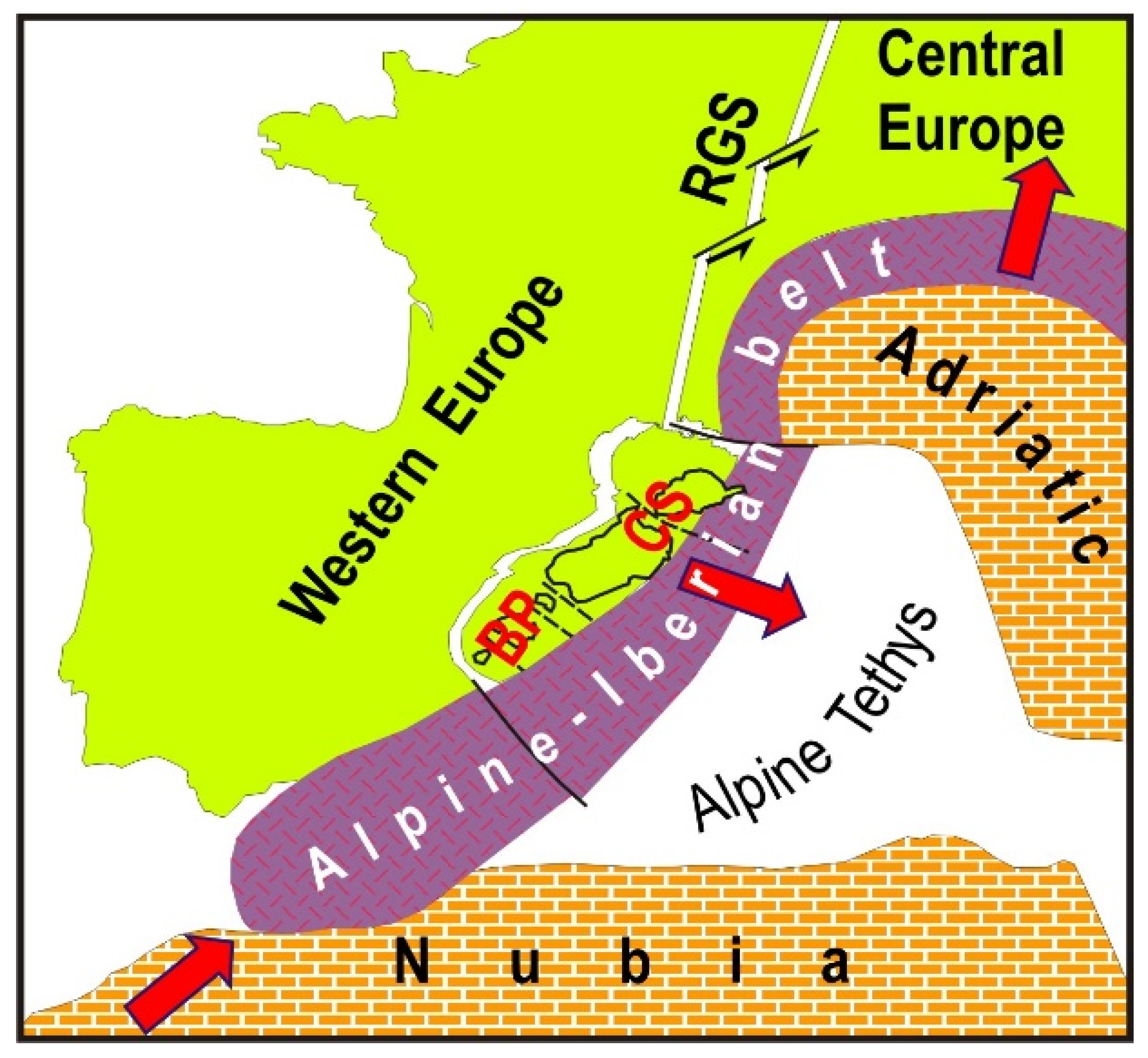
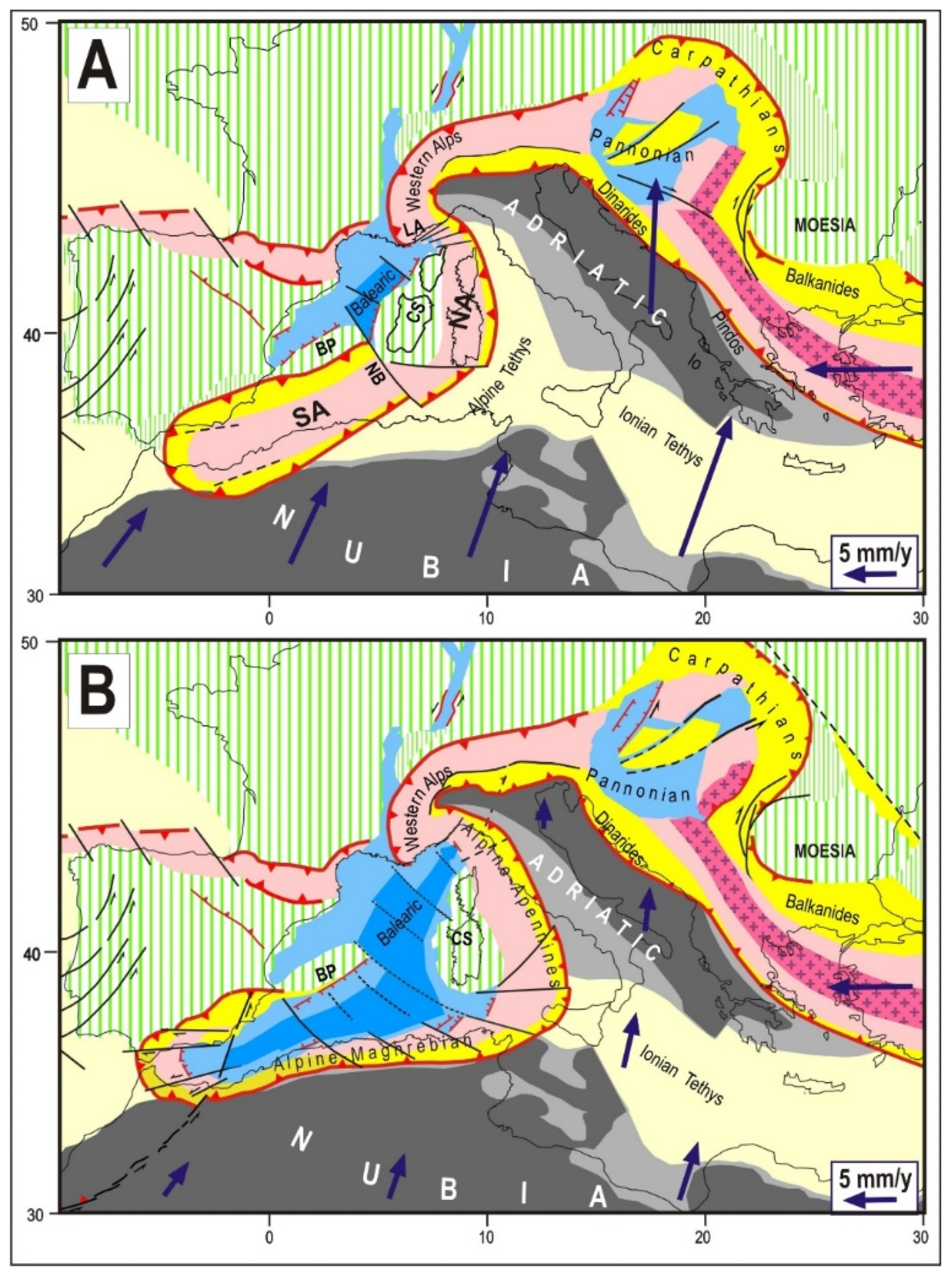

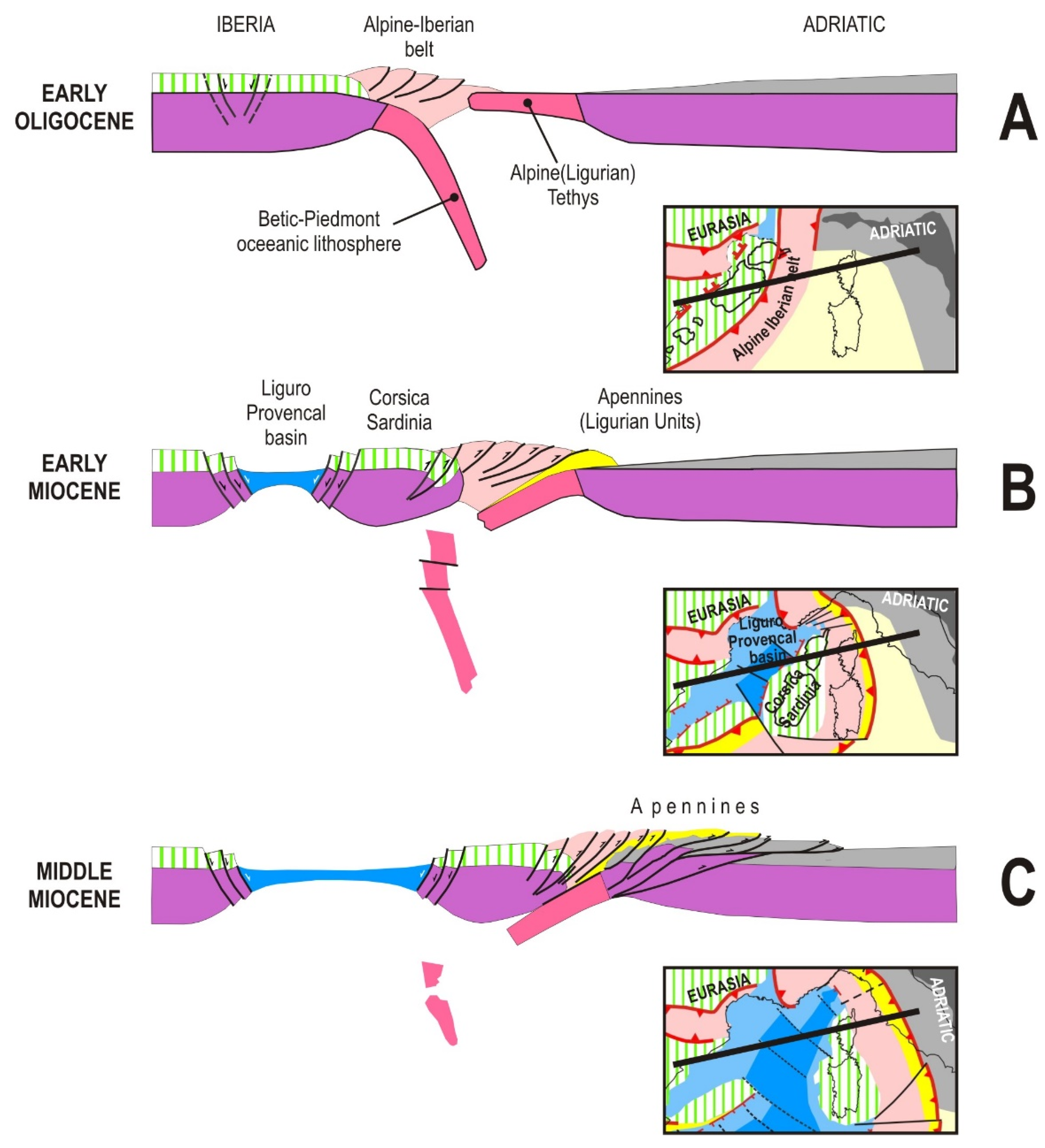
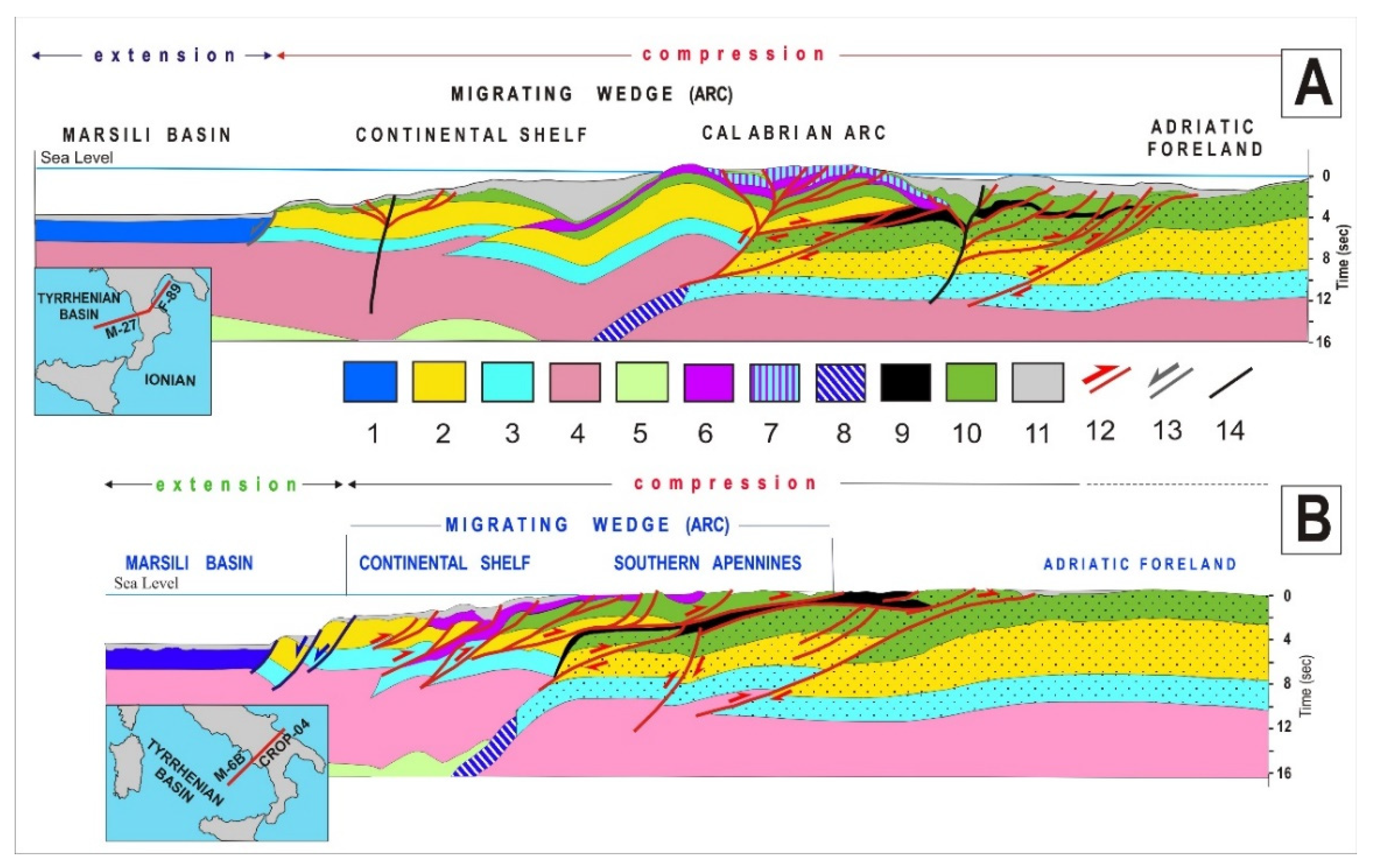
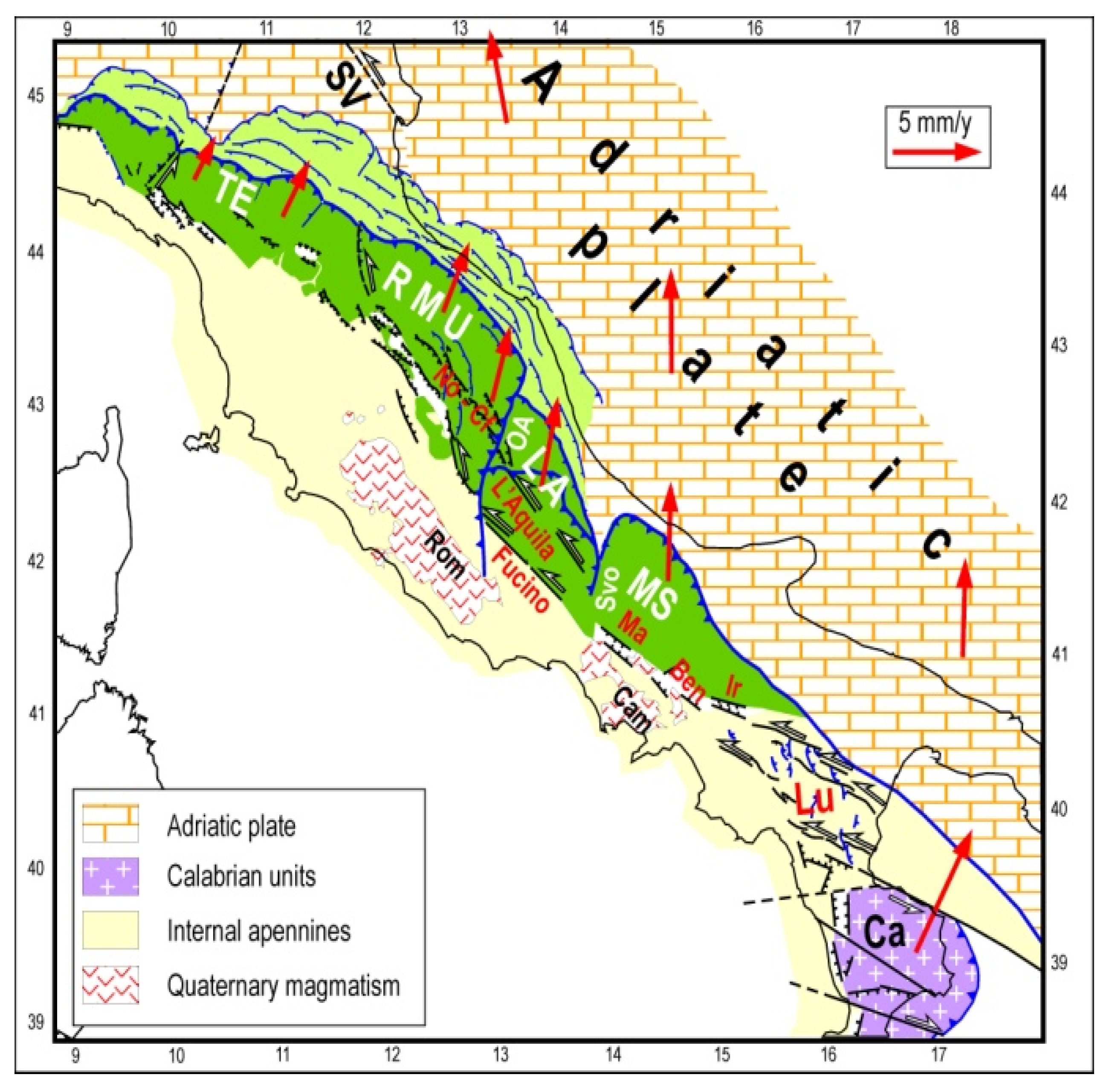
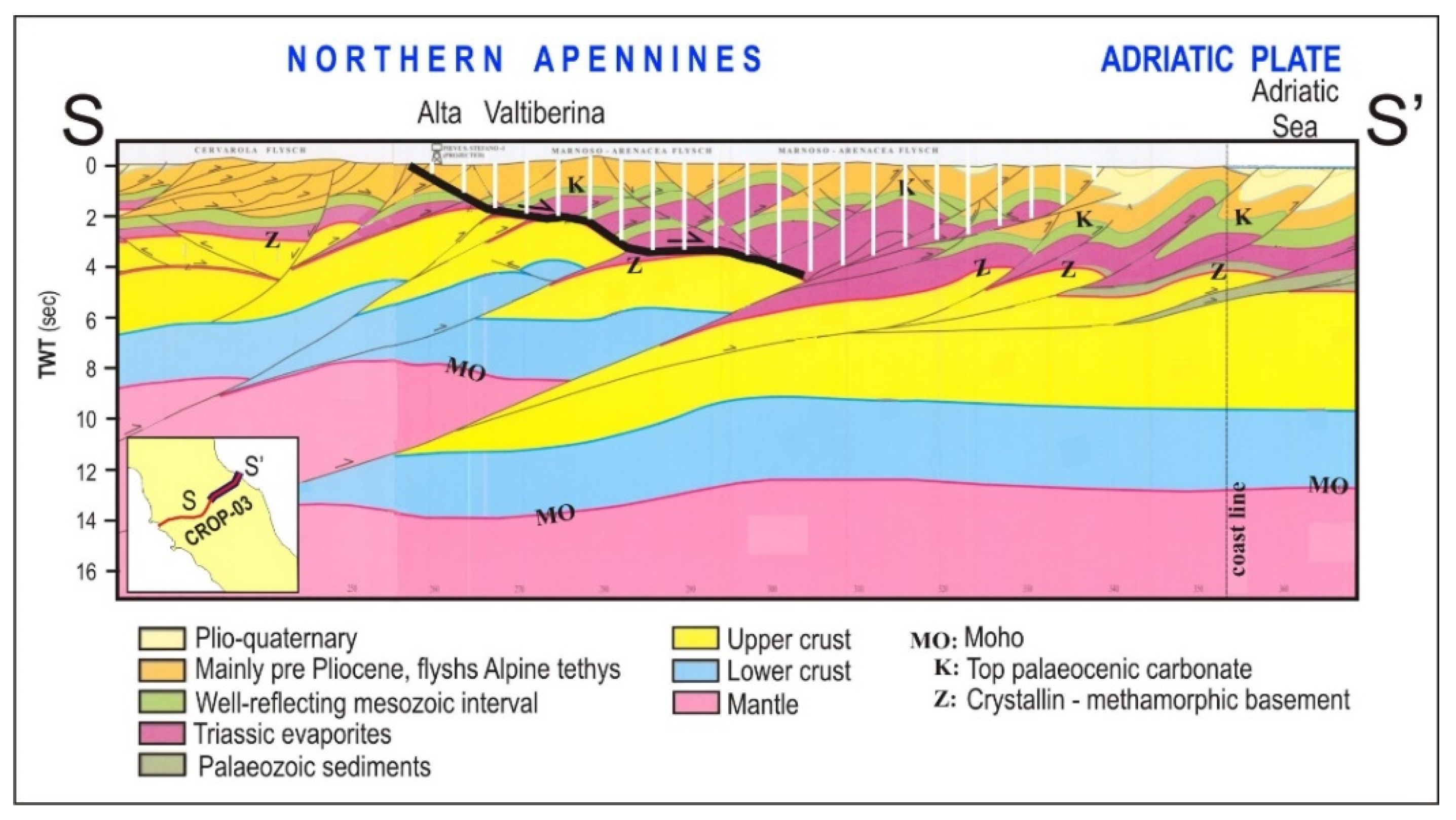
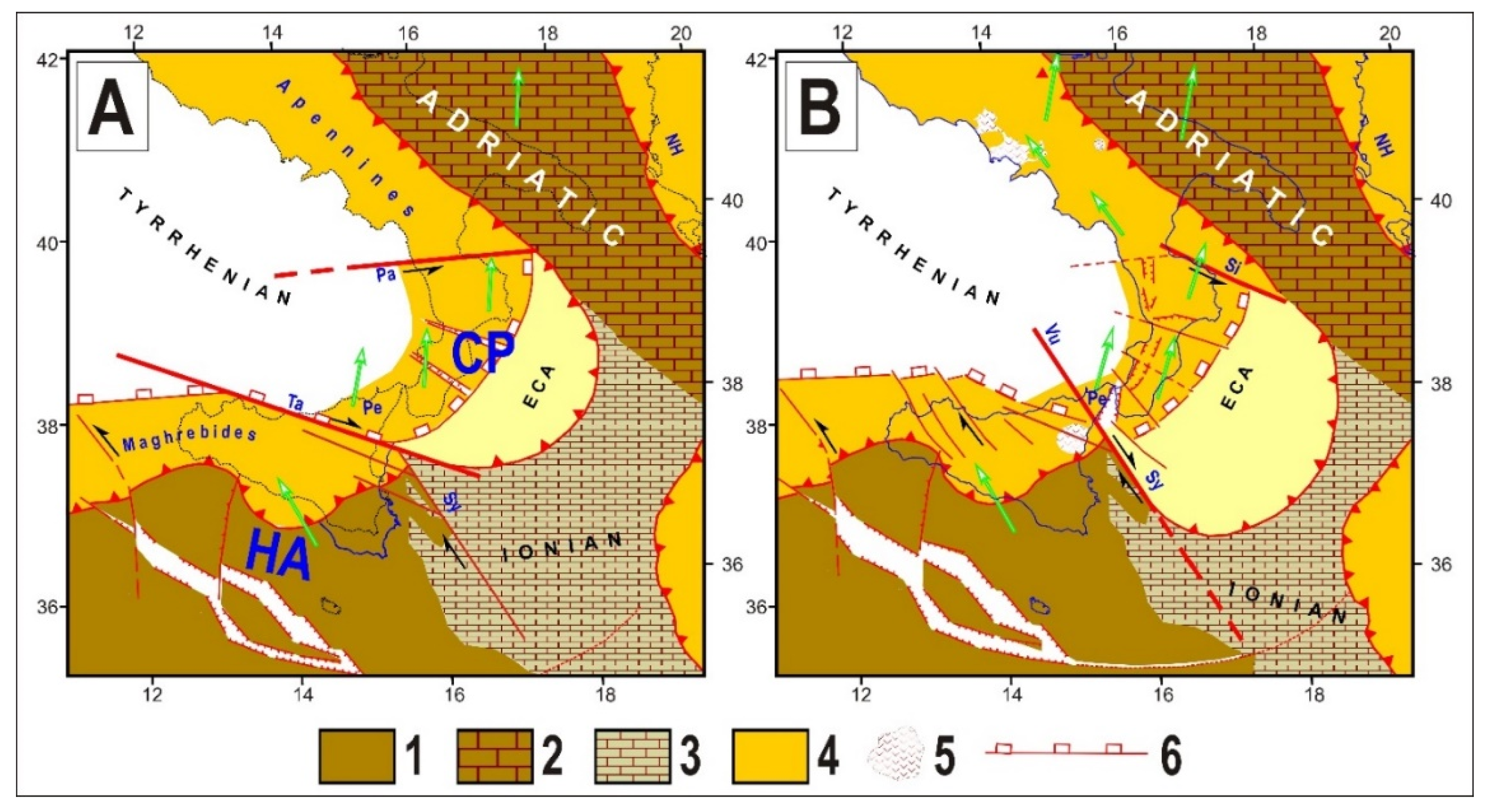
Publisher’s Note: MDPI stays neutral with regard to jurisdictional claims in published maps and institutional affiliations. |
© 2021 by the authors. Licensee MDPI, Basel, Switzerland. This article is an open access article distributed under the terms and conditions of the Creative Commons Attribution (CC BY) license (https://creativecommons.org/licenses/by/4.0/).
Share and Cite
Viti, M.; Mantovani, E.; Babbucci, D.; Tamburelli, C.; Caggiati, M.; Riva, A. Basic Role of Extrusion Processes in the Late Cenozoic Evolution of the Western and Central Mediterranean Belts. Geosciences 2021, 11, 499. https://doi.org/10.3390/geosciences11120499
Viti M, Mantovani E, Babbucci D, Tamburelli C, Caggiati M, Riva A. Basic Role of Extrusion Processes in the Late Cenozoic Evolution of the Western and Central Mediterranean Belts. Geosciences. 2021; 11(12):499. https://doi.org/10.3390/geosciences11120499
Chicago/Turabian StyleViti, Marcello, Enzo Mantovani, Daniele Babbucci, Caterina Tamburelli, Marcello Caggiati, and Alberto Riva. 2021. "Basic Role of Extrusion Processes in the Late Cenozoic Evolution of the Western and Central Mediterranean Belts" Geosciences 11, no. 12: 499. https://doi.org/10.3390/geosciences11120499





